On this day in 1970, the man who unexpectedly filmed the assassination of JFK, Abraham Zapruder died of stomach cancer in Dallas at the age of 65. Born into a Russian-Jewish family in the city of Kovel in Ukraine on 15 May 1905. The Final Footprint – Zapruder is interred in Emanu-El Cemetery in Dallas. His wife was interred next to him after her death in 1993. Their graves are marked by a companion engraved flat granite marker.
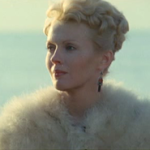 On this day in 1979, actress Jean Seberg died at the age of 40 from an apparent intentional overdose of barbiturates in the back seat of her Renault, which was parked close to her Paris apartment in the 16th arrondissement. Born Jean Dorothy Seberg on 13 November 1938 in Marshalltown, Iowa. She starred in 37 films in Hollywood and in Europe, including Bonjour Tristesse (1958), À bout de soufflé (Breathless) (1960), the musical Paint Your Wagon (1969), and the disaster film Airport (1970). Seberg is also one of the best-known targets of the FBI COINTELPRO project. Her victimization was rendered as a well-documented retaliation for her support of civil rights and activist groups in the 1960s. Seberg married François Moreuil (1958 – 1960 divorce), Romain Gary (1963 – 1970 divorce) and Dennis Berry (1972 – 1979 separated, her death).
On this day in 1979, actress Jean Seberg died at the age of 40 from an apparent intentional overdose of barbiturates in the back seat of her Renault, which was parked close to her Paris apartment in the 16th arrondissement. Born Jean Dorothy Seberg on 13 November 1938 in Marshalltown, Iowa. She starred in 37 films in Hollywood and in Europe, including Bonjour Tristesse (1958), À bout de soufflé (Breathless) (1960), the musical Paint Your Wagon (1969), and the disaster film Airport (1970). Seberg is also one of the best-known targets of the FBI COINTELPRO project. Her victimization was rendered as a well-documented retaliation for her support of civil rights and activist groups in the 1960s. Seberg married François Moreuil (1958 – 1960 divorce), Romain Gary (1963 – 1970 divorce) and Dennis Berry (1972 – 1979 separated, her death).
 The Final Footprint – Seberg was interred in the Cimetière du Montparnasse, Paris. Montparnasse Cemetery is the eternal home of many of France’s intellectual and artistic elite as well as publishers and others who promoted the works of authors and artists. There are also monuments to police and firefighters killed in the line of duty in the city of Paris. There are also many graves of foreigners who have made France their home. The cemetery is divided by Rue Émile Richard. The small section is usually referred to as the small cemetery (petit cimetière) and the large section as the big cemetery (grand cimetière). Other notable Final Footprints at Montparnasse include; Charles Baudelaire, Simone de Beauvoir, Samuel Beckett, Emmanuel Chabrier, Alfred Dreyfus, Marguerite Duras, Henri Fantin-Latour, César Franck, André Lhote, Guy de Maupassant, Adah Isaacs Menken, Man Ray, Camille Saint-Saëns, Jean-Paul Sartre, and Susan Sontag.
The Final Footprint – Seberg was interred in the Cimetière du Montparnasse, Paris. Montparnasse Cemetery is the eternal home of many of France’s intellectual and artistic elite as well as publishers and others who promoted the works of authors and artists. There are also monuments to police and firefighters killed in the line of duty in the city of Paris. There are also many graves of foreigners who have made France their home. The cemetery is divided by Rue Émile Richard. The small section is usually referred to as the small cemetery (petit cimetière) and the large section as the big cemetery (grand cimetière). Other notable Final Footprints at Montparnasse include; Charles Baudelaire, Simone de Beauvoir, Samuel Beckett, Emmanuel Chabrier, Alfred Dreyfus, Marguerite Duras, Henri Fantin-Latour, César Franck, André Lhote, Guy de Maupassant, Adah Isaacs Menken, Man Ray, Camille Saint-Saëns, Jean-Paul Sartre, and Susan Sontag.
#RIP #OTD in 1981 dancer, actress (On the Town, White Christmas) Vera-Ellen died at the Los Angeles County General Hospital of ovarian cancer aged 60. Glen Haven Memorial Park, Sylmar, California
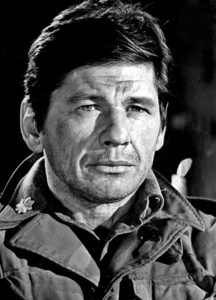 On this day in 2003 actor Charles Bronson died of pneumonia at Cedars-Sinai Medical Center in Los Angeles at the age of 81. Born Charles Dennis Buchinski 3 November 1921 in Ehrenfeld, Pennsylvania. My favorite Bronson movies inlcude: John Sturges’ The Magnificent Seven (1960) with Yul Brynner, Steve McQueen, James Coburn, Robert Vaughn and Eli Wallach and filmscore by Elmer Bernstein; The Dirty Dozen (1967) with Lee Marvin, Ernest Borgnine, Telly Savalas, and Jim Brown; Sergio Leone’s Once Upon a Time in the West (1968) with Claudia Cardinale, Henry Fonda and Jason Robards; as Wild Bill Hickok in The White Buffalo (1977) with Kim Novak, Jack Warden, Slim Pickens and Will Sampson; as Albert Johnson in Death Hunt (1981) with Lee Marvin, Angie Dickinson and Carl Weathers. Bronson was married three times; Harriet Tendler (1949-1967 divorce), actress Jill Ireland (1968-1990 her death) and Kim Weeks (1998-2003 his death).
On this day in 2003 actor Charles Bronson died of pneumonia at Cedars-Sinai Medical Center in Los Angeles at the age of 81. Born Charles Dennis Buchinski 3 November 1921 in Ehrenfeld, Pennsylvania. My favorite Bronson movies inlcude: John Sturges’ The Magnificent Seven (1960) with Yul Brynner, Steve McQueen, James Coburn, Robert Vaughn and Eli Wallach and filmscore by Elmer Bernstein; The Dirty Dozen (1967) with Lee Marvin, Ernest Borgnine, Telly Savalas, and Jim Brown; Sergio Leone’s Once Upon a Time in the West (1968) with Claudia Cardinale, Henry Fonda and Jason Robards; as Wild Bill Hickok in The White Buffalo (1977) with Kim Novak, Jack Warden, Slim Pickens and Will Sampson; as Albert Johnson in Death Hunt (1981) with Lee Marvin, Angie Dickinson and Carl Weathers. Bronson was married three times; Harriet Tendler (1949-1967 divorce), actress Jill Ireland (1968-1990 her death) and Kim Weeks (1998-2003 his death).
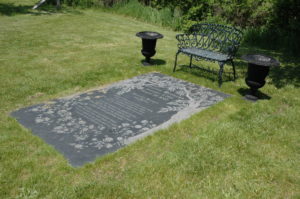 The Final Footprint – Bronson is buried in Brownsville Cemetery in West Windsor, Vermont. His grave is marked with a full ledger engraved granite marker. It is engraved with the term of endearment, Cherished Husband and Father and with the following popular bereavement poem by Mary Elizabeth Frye:
The Final Footprint – Bronson is buried in Brownsville Cemetery in West Windsor, Vermont. His grave is marked with a full ledger engraved granite marker. It is engraved with the term of endearment, Cherished Husband and Father and with the following popular bereavement poem by Mary Elizabeth Frye:
Do not stand at my grave and weep.
I am not here. I do not sleep.
I am a thousand winds that blow.
I am the diamond’s glints on snow.
I am the sunlight on ripened grain.
I am the autumns’ gentle rain.
When you awaken in the morning’s rush,
I am the swift uplifting rush,
Of quiet birds in circled flight.
I am the soft stars that shine at night.
Do not stand at my grave and cry.
I am not here, I did not die
O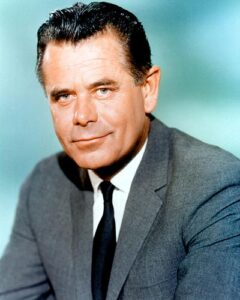 n this day in 2006 actor (Gilda, The Big Heat, Blackboard Jungle, 3:10 to Yuma, Superman) Glenn Ford died in his Beverly Hills home at the age of 90. He often portrayed ordinary men in unusual circumstances. Ford was most prominent during Hollywood’s Golden Age as one of the biggest box-office draws of the 1940s, 1950s, and 1960s, who had a career that lasted more than 50 years. Although he played in many genres of movies, some of his most significant roles were in the film noirs Gilda (1946) and The Big Heat (1953), and the high school angst film Blackboard Jungle (1955). However, it was for comedies or westerns which he received acting laurels, including three Golden Globe Nominations for Best Actor in a Comedy movie, winning for Pocketful of Miracles (1961). He also played a supporting role as Clark Kent’s adoptive father, Jonathan Kent, in Superman (1978). Five of his films have been selected for the National Film Registry by the Library of Congress as being “culturally, historically or aesthetically” significant: Gilda (1946), The Big Heat (1953), Blackboard Jungle (1955), 3:10 to Yuma (1957) and Superman (1978).
n this day in 2006 actor (Gilda, The Big Heat, Blackboard Jungle, 3:10 to Yuma, Superman) Glenn Ford died in his Beverly Hills home at the age of 90. He often portrayed ordinary men in unusual circumstances. Ford was most prominent during Hollywood’s Golden Age as one of the biggest box-office draws of the 1940s, 1950s, and 1960s, who had a career that lasted more than 50 years. Although he played in many genres of movies, some of his most significant roles were in the film noirs Gilda (1946) and The Big Heat (1953), and the high school angst film Blackboard Jungle (1955). However, it was for comedies or westerns which he received acting laurels, including three Golden Globe Nominations for Best Actor in a Comedy movie, winning for Pocketful of Miracles (1961). He also played a supporting role as Clark Kent’s adoptive father, Jonathan Kent, in Superman (1978). Five of his films have been selected for the National Film Registry by the Library of Congress as being “culturally, historically or aesthetically” significant: Gilda (1946), The Big Heat (1953), Blackboard Jungle (1955), 3:10 to Yuma (1957) and Superman (1978).
Ford’s first wife was actress and dancer Eleanor Powell (1943–1959), with whom he had his only child, actor Peter Ford (born 1945). The couple appeared together on screen once in a short film produced in the 1950s titled Have Faith in Our Children. When they married, Powell was more famous than Ford. Ford and Powell would divorce in 1959.
Ford did not remain on good terms with his ex-wives. He was a notorious womanizer who had affairs with many of his leading ladies, including Rita Hayworth, Maria Schell, Geraldine Brooks, Stella Stevens, Gloria Grahame, Gene Tierney, Eva Gabor, and Barbara Stanwyck. He had a one-night stand with Marilyn Monroe in 1962 and a fling with Joan Crawford in the early 1940s.
Ford dated Christiane Schmidtmer, Linda Christian and Vikki Dougan during the mid-1960s, and he also had relationships with Judy Garland, Connie Stevens, Suzanne Pleshette, Rhonda Fleming, Roberta Collins, Susie Lund, Terry Moore, Angie Dickinson, Debbie Reynolds, Jill St. John, Brigitte Bardot, and Loretta Young. He subsequently married actress Kathryn Hays (1966–1969); marriages to Cynthia Hayward (1977–1984), and Jeanne Baus (1993–1994) would later follow. All four marriages would end in divorce. He also had a long-term relationship with actress Hope Lange in the early 1960s. According to his son Peter Ford’s book Glenn Ford: A Life (2011), Ford had affairs with 146 actresses, all of which were documented in his personal diaries, including a 40-year, on-and off-again affair with Hayworth that began during the filming of Gilda in 1945. Their affair resumed during the making of their 1948 film The Loves of Carmen; Ford impregnated Hayworth, and she later traveled to France to get an abortion.
In 1960, Ford would move next door to Hayworth in Beverly Hills, and they continued their relationship for many years until the early 1980s.
Ford’s affair with stripper and cult actress Liz Renay was chronicled by her in the 1991 book My First 2,000 Men. She ranked Ford as one of her top five best lovers.
 The Final Footprint– Entombed in Woodlawn Memorial Cemetery, Santa Monica, California. Other notable Final Footprints at Woodlawn include; Barbara Billingsley, Harvey Korman, Doug McClure, Bess Myerson, Sally Ride, and Irene Ryan.
The Final Footprint– Entombed in Woodlawn Memorial Cemetery, Santa Monica, California. Other notable Final Footprints at Woodlawn include; Barbara Billingsley, Harvey Korman, Doug McClure, Bess Myerson, Sally Ride, and Irene Ryan.
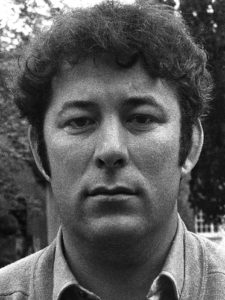 On this day in 2013, poet, playwright Seamus Heaney died in the Blackrock Clinic in Dublin, aged 74. Born Seamus Justin Heaney on 13 April 1939 in the townland of Tamniaran between Castledawson and Toomebridge, Northern Ireland. He received the 1995 Nobel Prize in Literature. Perhaps best known for his work Death of a Naturalist (1966), his first major published volume. Robert Lowell described him as “the most important Irish poet since Yeats”.
On this day in 2013, poet, playwright Seamus Heaney died in the Blackrock Clinic in Dublin, aged 74. Born Seamus Justin Heaney on 13 April 1939 in the townland of Tamniaran between Castledawson and Toomebridge, Northern Ireland. He received the 1995 Nobel Prize in Literature. Perhaps best known for his work Death of a Naturalist (1966), his first major published volume. Robert Lowell described him as “the most important Irish poet since Yeats”.
His family moved to Bellaghy when he was a boy. He became a lecturer at St. Joseph’s College in Belfast in the early 1960s, after attending Queen’s University and began to publish poetry. He lived in Sandymount, Dublin, from 1976 until his death. He lived part-time in the United States from 1981 to 2006.
Heaney was a professor at Harvard from 1981 to 1997, and its Poet in Residence from 1988 to 2006. From 1989 to 1994, he was also the Professor of Poetry at Oxford. In 1996, was made a Commandeur de l’Ordre des Arts et des Lettres and in 1998 was bestowed the title Saoi of the Aosdána. Other awards that he received include the Geoffrey Faber Memorial Prize (1968), the E. M. Forster Award (1975), the PEN Translation Prize (1985), the Golden Wreath of Poetry (2001), the T. S. Eliot Prize (2006) and two Whitbread Prizes (1996 and 1999). In 2011, he was awarded the Griffin Poetry Prize and in 2012, a Lifetime Recognition Award from the Griffin Trust. His literary papers are held by the National Library of Ireland.
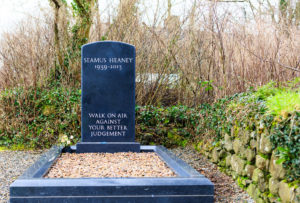 The Final Footprint
The Final Footprint
His son Michael revealed at the funeral mass that his father texted his final words, “Noli timere” (Latin: “Do not be afraid”), to his wife, Marie, minutes before he died.
His funeral was broadcast live the following day on RTÉ television and radio and was streamed internationally at RTÉ’s website. RTÉ Radio 1 Extra transmitted a continuous broadcast, from 8 a.m. to 9:15 p.m. on the day of the funeral, of his Collected Poems album, recorded by Heaney in 2009. His poetry collections sold out rapidly in Irish bookshops immediately following his death.
He is buried at the Cemetery of St Mary’s Church, Bellaghy, Northern Ireland, in the same graveyard as his parents, young brother, and other family members. The headstone bears the epitaph “Walk on air against your better judgement”, from one of his poems, “The Gravel Walks”.
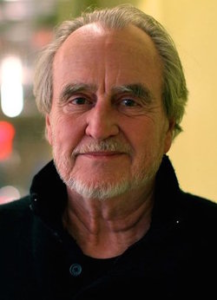 On this day in 2015 film director, writer, producer, actor, Master of Horror Wes Craven died of brain cancer at his Los Angeles home at the age of 76. Born Wesley Earl Craven on August 2, 1939 in Cleveland, Ohio. Perhaps best known for his pioneering work in the genre of horror films, particularly slasher films, where he mixed horror cliches with humor and satire. His impact on the genre was considered prolific and influential.
On this day in 2015 film director, writer, producer, actor, Master of Horror Wes Craven died of brain cancer at his Los Angeles home at the age of 76. Born Wesley Earl Craven on August 2, 1939 in Cleveland, Ohio. Perhaps best known for his pioneering work in the genre of horror films, particularly slasher films, where he mixed horror cliches with humor and satire. His impact on the genre was considered prolific and influential.
He is best known for creating A Nightmare on Elm Street (1984) and Scream (1996), featuring the characters of Freddy Krueger, Nancy Thompson, Ghostface, and Sidney Prescott. His other films include The Last House on the Left (1972), The Hills Have Eyes (1977), Swamp Thing (1982), The Serpent and the Rainbow (1988), The People Under the Stairs (1991), Vampire in Brooklyn (1995), Music of the Heart (1999), and Red Eye (2005).
Craven’s first marriage was to Bonnie Broecker. The marriage ended in 1970. In 1982, Craven married a woman who became known professionally as actress Mimi Craven. The two later divorced, with Wes Craven stating in interviews that the marriage dissolved after he discovered it “was no longer anything but a sham”. In 2004, Craven married Iya Labunka; she frequently worked as a producer on Craven’s films.
Craven was a birder; in 2010, he joined Audubon California’s Board of Directors. His favorite films included Night of the Living Dead (1968), The Virgin Spring (1960) and Red River (1948).
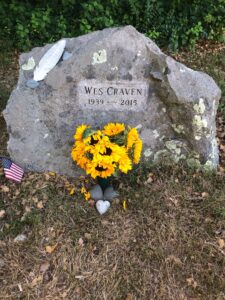 The Final Footprint
The Final Footprint
Lambert’s Cove Cemetery, West Tisbury, Dukes County, Massachusetts.
#RIP #OTD in 2019 actress (The Mary Tyler Moore Show, Rhoda, Freebie and the Bean, Chapter Two) Valerie Harper died from lung cancer in Los Angeles aged 80. Hollywood Forever Cemetery
Have you planned yours yet?
Follow us on twitter @RIPTFF

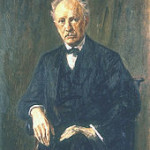 On this day in 1949, composer of the late Romantic and early Modern eras, Richard Strauss died at the age of 85 in Garmisch-Partenkirchen, Germany. Born Richard Georg Strauss on 11 June 1864 in Munich. He is known for his operas, which include Der Rosenkavalier and Salome; his lieder, especially his Four Last Songs; and his tone poems Death and Transfiguration, Till Eulenspiegel’s Merry Pranks, Also sprach Zarathustra, An Alpine Symphony; and other orchestral works, such as Metamorphosen. Strauss was also a prominent conductor throughout Germany and Austria. Strauss, along with Gustav Mahler, represents the late flowering of German Romanticism after Richard Wagner, in which pioneering subtleties of orchestration are combined with an advanced harmonic style.
On this day in 1949, composer of the late Romantic and early Modern eras, Richard Strauss died at the age of 85 in Garmisch-Partenkirchen, Germany. Born Richard Georg Strauss on 11 June 1864 in Munich. He is known for his operas, which include Der Rosenkavalier and Salome; his lieder, especially his Four Last Songs; and his tone poems Death and Transfiguration, Till Eulenspiegel’s Merry Pranks, Also sprach Zarathustra, An Alpine Symphony; and other orchestral works, such as Metamorphosen. Strauss was also a prominent conductor throughout Germany and Austria. Strauss, along with Gustav Mahler, represents the late flowering of German Romanticism after Richard Wagner, in which pioneering subtleties of orchestration are combined with an advanced harmonic style.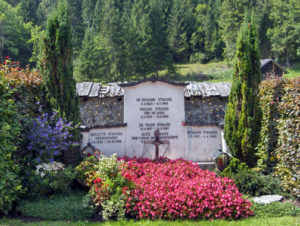 The Final Footprint – Strauss was cremated and his cremated remains were interred in the garden of his villa in Garmisch, in the Bavarian Alps. Georg Solti, who had arranged Strauss’s 85th birthday celebration, also directed an orchestra during Strauss’s burial. The conductor later described how, during the singing of the famous trio from Rosenkavalier, “each singer broke down in tears and dropped out of the ensemble, but they recovered themselves and we all ended together.” Strauss’s wife, Pauline de Ahna, died eight months later, on 13 May 1950, at the age of 88.
The Final Footprint – Strauss was cremated and his cremated remains were interred in the garden of his villa in Garmisch, in the Bavarian Alps. Georg Solti, who had arranged Strauss’s 85th birthday celebration, also directed an orchestra during Strauss’s burial. The conductor later described how, during the singing of the famous trio from Rosenkavalier, “each singer broke down in tears and dropped out of the ensemble, but they recovered themselves and we all ended together.” Strauss’s wife, Pauline de Ahna, died eight months later, on 13 May 1950, at the age of 88.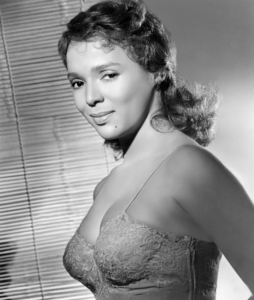 On this day in 1965, actress and singer, Academy Award nominee, Dorothy Dandridge died at the age of 42 either from an accidental overdose of prescription medication or an embolism at her home in West Hollywood. Born Dorothy Jean Dandridge on 9 November 1922, in Cleveland, Ohio. She was the first African-American to be nominated for an Academy Award for Best Actress. She performed as a vocalist in venues such as the Cotton Club and the Apollo Theater. After many bit parts, and a few minor roles, Dandridge landed her first notable film role in Tarzan’s Peril (starring Lex Barker), in 1951. She won her first starring role in 1953, playing a teacher in a low-budget film with a nearly all-black cast, Bright Road, released by Metro-Goldwyn-Mayer. In 1954, she was nominated for an Academy Award for Best Actress and a BAFTA Award for Best Actress in a Leading Role for Carmen Jones. In 1959, she was nominated for a Golden Globe Award for Best Actress in a Motion Picture Musical or Comedy for her role as Bess in Otto Preminger’s film adaptation of the Gershwin/Heyward/Gershwin opera, Porgy and Bess. In 1999, she was the subject of the HBO biopic Introducing Dorothy Dandridge, starring Halle Berry as Dandridge. Dandridge was married and divorced twice: first, to dancer and entertainer Harold Nicholas (the father of her daughter, Harolyn Suzanne), and then to Jack Denison.
On this day in 1965, actress and singer, Academy Award nominee, Dorothy Dandridge died at the age of 42 either from an accidental overdose of prescription medication or an embolism at her home in West Hollywood. Born Dorothy Jean Dandridge on 9 November 1922, in Cleveland, Ohio. She was the first African-American to be nominated for an Academy Award for Best Actress. She performed as a vocalist in venues such as the Cotton Club and the Apollo Theater. After many bit parts, and a few minor roles, Dandridge landed her first notable film role in Tarzan’s Peril (starring Lex Barker), in 1951. She won her first starring role in 1953, playing a teacher in a low-budget film with a nearly all-black cast, Bright Road, released by Metro-Goldwyn-Mayer. In 1954, she was nominated for an Academy Award for Best Actress and a BAFTA Award for Best Actress in a Leading Role for Carmen Jones. In 1959, she was nominated for a Golden Globe Award for Best Actress in a Motion Picture Musical or Comedy for her role as Bess in Otto Preminger’s film adaptation of the Gershwin/Heyward/Gershwin opera, Porgy and Bess. In 1999, she was the subject of the HBO biopic Introducing Dorothy Dandridge, starring Halle Berry as Dandridge. Dandridge was married and divorced twice: first, to dancer and entertainer Harold Nicholas (the father of her daughter, Harolyn Suzanne), and then to Jack Denison.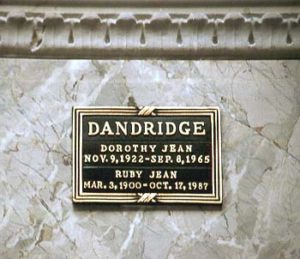 The Final Footprint – On 12 September 1965, a private funeral service was held for Dandridge at the Little Chapel of the Flowers; she was then cremated and her cremated remains inurned in the Freedom Mausoleum at Forest Lawn Memorial Park, Glendale. For her contributions to the motion picture industry, she was given a star on the Hollywood Walk of Fame, at 671 Hollywood Boulevard. Dandridge is a prominent figure in a huge mural of celebrities painted on an exterior wall of Hollywood High School. Dandridge has a statue at Hollywood-La Brea Boulevard in Los Angeles, designed by Catherine Hardwicke, built to honor multi-ethnic leading ladies of the cinema, including Mae West, Dolores del Rio and Anna May Wong. Other notable Final Footprints at Forest Lawn Glendale include; L. Frank Baum, Humphrey Bogart, Lon Chaney, Nat King Cole, Sam Cooke, Sammy Davis, Jr., Walt Disney, Errol Flynn, Clark Gable, Jean Harlow, Michael Jackson, Carole Lombard, Tom Mix, Casey Stengel, Jimmy Stewart, Elizabeth Taylor, and Spencer Tracy.
The Final Footprint – On 12 September 1965, a private funeral service was held for Dandridge at the Little Chapel of the Flowers; she was then cremated and her cremated remains inurned in the Freedom Mausoleum at Forest Lawn Memorial Park, Glendale. For her contributions to the motion picture industry, she was given a star on the Hollywood Walk of Fame, at 671 Hollywood Boulevard. Dandridge is a prominent figure in a huge mural of celebrities painted on an exterior wall of Hollywood High School. Dandridge has a statue at Hollywood-La Brea Boulevard in Los Angeles, designed by Catherine Hardwicke, built to honor multi-ethnic leading ladies of the cinema, including Mae West, Dolores del Rio and Anna May Wong. Other notable Final Footprints at Forest Lawn Glendale include; L. Frank Baum, Humphrey Bogart, Lon Chaney, Nat King Cole, Sam Cooke, Sammy Davis, Jr., Walt Disney, Errol Flynn, Clark Gable, Jean Harlow, Michael Jackson, Carole Lombard, Tom Mix, Casey Stengel, Jimmy Stewart, Elizabeth Taylor, and Spencer Tracy.
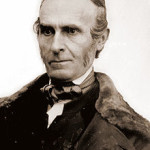 On this day in 1892, influential Quaker poet, ardent advocate of the abolition of slavery in the United States, , John Greenleaf Whittier died at the age of 84 at a friend’s home in Hampton Falls, New Hampshire. Born near Haverhill, Massachusetts, on 17 December 1807. He is usually listed as one of the Fireside Poets along with Henry Wadsworth Longfellow, William Cullen Bryant, James Russell Lowell, and Oliver Wendell Holmes. Whittier appears to have been strongly influenced by the Scottish poet Robert Burns. Perhaps best remembered for his poem Snow-Bound, and the words of the hymn Dear Lord and Father of Mankind, from his poem “The Brewing of Soma”, sung to music by Hubert Parry.
On this day in 1892, influential Quaker poet, ardent advocate of the abolition of slavery in the United States, , John Greenleaf Whittier died at the age of 84 at a friend’s home in Hampton Falls, New Hampshire. Born near Haverhill, Massachusetts, on 17 December 1807. He is usually listed as one of the Fireside Poets along with Henry Wadsworth Longfellow, William Cullen Bryant, James Russell Lowell, and Oliver Wendell Holmes. Whittier appears to have been strongly influenced by the Scottish poet Robert Burns. Perhaps best remembered for his poem Snow-Bound, and the words of the hymn Dear Lord and Father of Mankind, from his poem “The Brewing of Soma”, sung to music by Hubert Parry.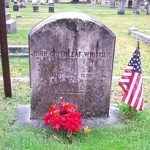 The Final Footprint – Whittier is interred in Union Cemetery in Amesbury, Massachusetts. Whittier’s family farm, known as the John Greenleaf Whittier Homestead or simply “Whittier’s Birthplace”, is now a historic site open to the public. His later residence in Amesbury, where he lived for 56 years, is also open to the public, now known as the John Greenleaf Whittier Home. Whittier’s hometown of Haverhill has named many buildings and landmarks in his honor including J.G. Whittier Middle School, Greenleaf Elementary, and Whittier Regional Vocational Technical High School. Numerous other schools around the country also bear his name.
The Final Footprint – Whittier is interred in Union Cemetery in Amesbury, Massachusetts. Whittier’s family farm, known as the John Greenleaf Whittier Homestead or simply “Whittier’s Birthplace”, is now a historic site open to the public. His later residence in Amesbury, where he lived for 56 years, is also open to the public, now known as the John Greenleaf Whittier Home. Whittier’s hometown of Haverhill has named many buildings and landmarks in his honor including J.G. Whittier Middle School, Greenleaf Elementary, and Whittier Regional Vocational Technical High School. Numerous other schools around the country also bear his name.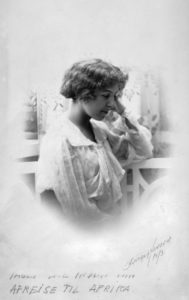 On this day in 1962, author Karen Blixen, Baroness Karen von Blixen-Finecke, died at Rungstedlund, her family’s estate in Denmark, at the age of 77. Born Karen Christenze Dinesen on 17 April 1885 in Rungsted, Denmark. Best known for her book Out of Africa, which was made into a movie starring Meryl Streep and Robert Redford as the English big game hunter Denys Finch Hatton. In 1913 Karen Dinesen became engaged to her second-cousin, the Swedish Baron Bror von Blixen-Finecke, after a failed love affair with his brother. The couple moved to Kenya, where in early 1914 they used family money to establish a coffee plantation, hiring African workers, predominantly the Kikuyu tribes people who lived on the farmlands at the time of their arrival. The Blixens separated in 1921, and were divorced in 1925. During her early years in Kenya, Blixen met Hatton and after her separation she and Hatton developed a close friendship which eventually became a long-term love affair.
On this day in 1962, author Karen Blixen, Baroness Karen von Blixen-Finecke, died at Rungstedlund, her family’s estate in Denmark, at the age of 77. Born Karen Christenze Dinesen on 17 April 1885 in Rungsted, Denmark. Best known for her book Out of Africa, which was made into a movie starring Meryl Streep and Robert Redford as the English big game hunter Denys Finch Hatton. In 1913 Karen Dinesen became engaged to her second-cousin, the Swedish Baron Bror von Blixen-Finecke, after a failed love affair with his brother. The couple moved to Kenya, where in early 1914 they used family money to establish a coffee plantation, hiring African workers, predominantly the Kikuyu tribes people who lived on the farmlands at the time of their arrival. The Blixens separated in 1921, and were divorced in 1925. During her early years in Kenya, Blixen met Hatton and after her separation she and Hatton developed a close friendship which eventually became a long-term love affair.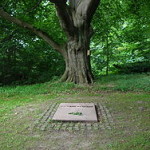 The Final Footprint – Blixen was buried at Rungstedlund under a large beech tree. Her full ledger flat marker simply states her name – Karen Blixen. In addition, the family estate has been turned into a museum and is open to the public.
The Final Footprint – Blixen was buried at Rungstedlund under a large beech tree. Her full ledger flat marker simply states her name – Karen Blixen. In addition, the family estate has been turned into a museum and is open to the public. On this day in 1978, musician, drummer, member of The Who, Keith Moon died at the age of 32 from an overdose of prescription medication in Harry Nilsson’s flat, No.12 at 9 Curzon Place (now called Curzon Square), Shepherd Market, Mayfair. Perhaps the greatest drummer in the history of rock. The Who emerged in 1964 with singer Roger Daltrey, guitarist Pete Townshend, bassist John Entwistle, and Moon. They combined popular singles, such as “My Generation” (1965), “Substitute” (1966), “I Can See for Miles” (1967), “Pinball Wizard” (1969), and “Won’t Get Fooled Again” (1971), with critically acclaimed albums such as the rock operas Tommy (1969), and Quadrophenia (1973). They are known for energetic live performances which, since a performance at the Railway Hotel in Wealdstone in June 1964 when Townshend smashed his guitar in anger and frustration, often include smashing their instruments. For much of their career they have been regarded as the third most important British rock act after the Beatles and the Rolling Stones. Moon died shortly after the release of Who Are You. On the album cover, he is seated on a chair back-to-front. The words “NOT TO BE TAKEN AWAY” appear on the back of the chair. Born Keith John Moon on 23 August 1946 in Wembley, Middlesex, London.
On this day in 1978, musician, drummer, member of The Who, Keith Moon died at the age of 32 from an overdose of prescription medication in Harry Nilsson’s flat, No.12 at 9 Curzon Place (now called Curzon Square), Shepherd Market, Mayfair. Perhaps the greatest drummer in the history of rock. The Who emerged in 1964 with singer Roger Daltrey, guitarist Pete Townshend, bassist John Entwistle, and Moon. They combined popular singles, such as “My Generation” (1965), “Substitute” (1966), “I Can See for Miles” (1967), “Pinball Wizard” (1969), and “Won’t Get Fooled Again” (1971), with critically acclaimed albums such as the rock operas Tommy (1969), and Quadrophenia (1973). They are known for energetic live performances which, since a performance at the Railway Hotel in Wealdstone in June 1964 when Townshend smashed his guitar in anger and frustration, often include smashing their instruments. For much of their career they have been regarded as the third most important British rock act after the Beatles and the Rolling Stones. Moon died shortly after the release of Who Are You. On the album cover, he is seated on a chair back-to-front. The words “NOT TO BE TAKEN AWAY” appear on the back of the chair. Born Keith John Moon on 23 August 1946 in Wembley, Middlesex, London.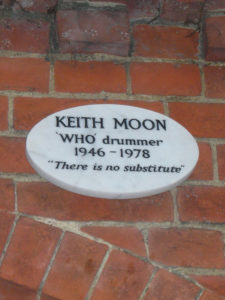 The Final Footprint – Moon was cremated on 13 September 1978, at Golders Green Crematorium in London and his ashes scattered in its Gardens of Remembrance. GGC was the first crematorium to be opened in London, and one of the oldest crematoria in Britain. The crematorium, the Philipson Family mausoleum, designed by Edwin Lutyens, the wall, along with memorials and gates, the Martin Smith Mausoleum, and Into The Silent Land statue are all Grade II listed buildings. The gardens are included in the National Register of Historic Parks and Gardens. GGC is in Hoop Lane, off Finchley Road, Golders Green, London NW11, ten minutes’ walk from Golders Green tube station. It is directly opposite the Golders Green Jewish Cemetery. The crematorium is secular, accepts all faiths and non-believers; clients may arrange their own type of service or remembrance event and choose whatever music they wish. Other notable cremations at GGC include; Kingsley Amis, Marc Bolan, Neville Chamberlain, T. S. Eliot, Sigmund Freud, Henry James, Rudyard Kipling, Vivien Leigh, Peter Sellers, Bram Stoker, H. G. Wells, and Amy Winehouse.
The Final Footprint – Moon was cremated on 13 September 1978, at Golders Green Crematorium in London and his ashes scattered in its Gardens of Remembrance. GGC was the first crematorium to be opened in London, and one of the oldest crematoria in Britain. The crematorium, the Philipson Family mausoleum, designed by Edwin Lutyens, the wall, along with memorials and gates, the Martin Smith Mausoleum, and Into The Silent Land statue are all Grade II listed buildings. The gardens are included in the National Register of Historic Parks and Gardens. GGC is in Hoop Lane, off Finchley Road, Golders Green, London NW11, ten minutes’ walk from Golders Green tube station. It is directly opposite the Golders Green Jewish Cemetery. The crematorium is secular, accepts all faiths and non-believers; clients may arrange their own type of service or remembrance event and choose whatever music they wish. Other notable cremations at GGC include; Kingsley Amis, Marc Bolan, Neville Chamberlain, T. S. Eliot, Sigmund Freud, Henry James, Rudyard Kipling, Vivien Leigh, Peter Sellers, Bram Stoker, H. G. Wells, and Amy Winehouse.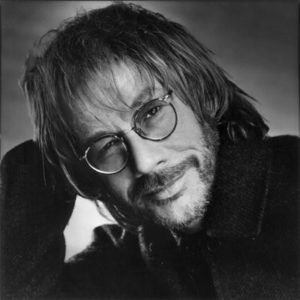 On this day in 2003, singer, songwriter, musician Warren Zevon died, aged 56, at his home in Los Angeles, California from cancer. Born Warren William Zevon on 24 January 1947 in Chicago. Perhaps his best-known compositions include “Werewolves of London”, “Excitable Boy”, “Lawyers, Guns and Money”, “Roland the Headless Thompson Gunner” and “Johnny Strikes Up the Band”, all of which are featured on his third album, Excitable Boy (1978). Other well-known songs written by Zevon have been recorded by other artists, including “Poor Poor Pitiful Me” (a top 40 hit by Linda Ronstadt), “Accidentally Like a Martyr”, “Mohammed’s Radio”, “Carmelita”, and “Hasten Down the Wind”. Along with his own compositions, Zevon recorded or performed occasional covers, including Allen Toussaint’s A Certain Girl, Bob Dylan’s “Knockin’ on Heaven’s Door” and Leonard Cohen’s “First We Take Manhattan”. He was a frequent guest on Late Night with David Letterman and the Late Show with David Letterman. Letterman later performed guest vocals on “Hit Somebody! (The Hockey Song)” with Paul Shaffer and members of the CBS Orchestra on Zevon’s My Ride’s Here album.
On this day in 2003, singer, songwriter, musician Warren Zevon died, aged 56, at his home in Los Angeles, California from cancer. Born Warren William Zevon on 24 January 1947 in Chicago. Perhaps his best-known compositions include “Werewolves of London”, “Excitable Boy”, “Lawyers, Guns and Money”, “Roland the Headless Thompson Gunner” and “Johnny Strikes Up the Band”, all of which are featured on his third album, Excitable Boy (1978). Other well-known songs written by Zevon have been recorded by other artists, including “Poor Poor Pitiful Me” (a top 40 hit by Linda Ronstadt), “Accidentally Like a Martyr”, “Mohammed’s Radio”, “Carmelita”, and “Hasten Down the Wind”. Along with his own compositions, Zevon recorded or performed occasional covers, including Allen Toussaint’s A Certain Girl, Bob Dylan’s “Knockin’ on Heaven’s Door” and Leonard Cohen’s “First We Take Manhattan”. He was a frequent guest on Late Night with David Letterman and the Late Show with David Letterman. Letterman later performed guest vocals on “Hit Somebody! (The Hockey Song)” with Paul Shaffer and members of the CBS Orchestra on Zevon’s My Ride’s Here album.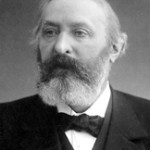 On this day in 1907, French poet and essayist, recipient of the first Nobel Prize in Literature, Sully Prudhomme died at Châtenay-Malabry, at the age of 68. Born René François Armand Prudhomme on 16 March 1839 in Paris. The first ever winner of the Nobel Prize in Literature, in 1901. Prudhomme originally studied to be an engineer, but turned to philosophy and later to poetry; he declared it as his intent to create scientific poetry for modern times. In character sincere and melancholic, he was linked to the Parnassus school, although his work displays characteristics of its own.
On this day in 1907, French poet and essayist, recipient of the first Nobel Prize in Literature, Sully Prudhomme died at Châtenay-Malabry, at the age of 68. Born René François Armand Prudhomme on 16 March 1839 in Paris. The first ever winner of the Nobel Prize in Literature, in 1901. Prudhomme originally studied to be an engineer, but turned to philosophy and later to poetry; he declared it as his intent to create scientific poetry for modern times. In character sincere and melancholic, he was linked to the Parnassus school, although his work displays characteristics of its own.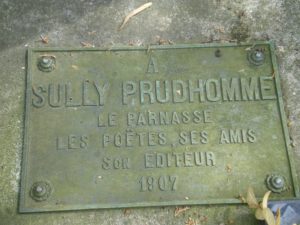
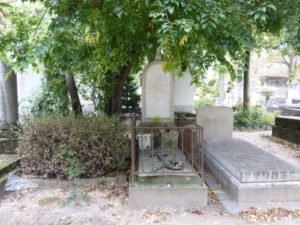
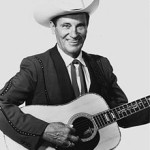 On this day in 1984, singer songwriter, The Texas Troubadour, the original E.T., Ernest Tubb died from emphysema in Nashville at the age of 70. Born Ernest Dale Tubb on 9 February 1914 in Ellis County Texas. One of the pioneers of country music, his biggest career hit song, “Walking the Floor Over You” (1941), marked the rise of the honky tonk style of music. In 1948, he was the first singer to record a hit version of “Blue Christmas”. Another well-known Tubb hit was “Waltz Across Texas” (1965), which became one of his most requested songs and is often used in dance halls throughout Texas during waltz lessons. Tubb recorded duets with the then up-and-coming Loretta Lynn in the early 1960s, including their hit “Sweet Thang”. Tubb is a member of the Country Music Hall of Fame. My favorite E.T. song is Waltz across Texas.
On this day in 1984, singer songwriter, The Texas Troubadour, the original E.T., Ernest Tubb died from emphysema in Nashville at the age of 70. Born Ernest Dale Tubb on 9 February 1914 in Ellis County Texas. One of the pioneers of country music, his biggest career hit song, “Walking the Floor Over You” (1941), marked the rise of the honky tonk style of music. In 1948, he was the first singer to record a hit version of “Blue Christmas”. Another well-known Tubb hit was “Waltz Across Texas” (1965), which became one of his most requested songs and is often used in dance halls throughout Texas during waltz lessons. Tubb recorded duets with the then up-and-coming Loretta Lynn in the early 1960s, including their hit “Sweet Thang”. Tubb is a member of the Country Music Hall of Fame. My favorite E.T. song is Waltz across Texas.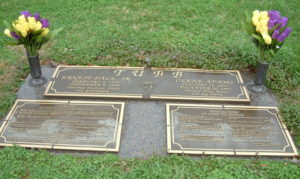 The Final Footprint – Tubb was buried at Hermitage Memorial Gardens, a
The Final Footprint – Tubb was buried at Hermitage Memorial Gardens, a  On this day in 2007, one of the greatest opera tenors, The King of the High C’s, Luciano Pavarotti, died of kidney failure brought on by pancreatic cancer, at his home in Modena, Italy, at the age of 71. Born 12 October 1935 in Modena. One of the most commercially successful tenors of all time. He made numerous recordings of complete operas and individual arias, gaining worldwide fame for the brilliance and beauty of his tone, especially into the upper register, and eventually established himself as one of the finest tenors of the 20th century. As one of The Three Tenors, Pavarotti became well known for his televised concerts and media appearances. From the beginning of his professional career as a tenor in 1961 in Italy to his final performance of “Nessun dorma” at the 2006 Winter Olympics in Turin, Pavarotti was at his best in bel operas, pre-Aida Verdi roles and Puccini works such as La bohème, Tosca, and Madama Butterfly. Pavarotti was also noted for his charity work on behalf of refugees and the Red Cross, amongst others. He made his opera debut in April 1961, in the role of Rudolfo in the opera La bohème. In 1963, he made his international debut in the same role at London’s Royal Opera House. He became the first tenor in opera history to hit all nine high C notes in the aria Quel Destin in the opera The Daughter of the Regiment by Gaetano Donizetti.
On this day in 2007, one of the greatest opera tenors, The King of the High C’s, Luciano Pavarotti, died of kidney failure brought on by pancreatic cancer, at his home in Modena, Italy, at the age of 71. Born 12 October 1935 in Modena. One of the most commercially successful tenors of all time. He made numerous recordings of complete operas and individual arias, gaining worldwide fame for the brilliance and beauty of his tone, especially into the upper register, and eventually established himself as one of the finest tenors of the 20th century. As one of The Three Tenors, Pavarotti became well known for his televised concerts and media appearances. From the beginning of his professional career as a tenor in 1961 in Italy to his final performance of “Nessun dorma” at the 2006 Winter Olympics in Turin, Pavarotti was at his best in bel operas, pre-Aida Verdi roles and Puccini works such as La bohème, Tosca, and Madama Butterfly. Pavarotti was also noted for his charity work on behalf of refugees and the Red Cross, amongst others. He made his opera debut in April 1961, in the role of Rudolfo in the opera La bohème. In 1963, he made his international debut in the same role at London’s Royal Opera House. He became the first tenor in opera history to hit all nine high C notes in the aria Quel Destin in the opera The Daughter of the Regiment by Gaetano Donizetti.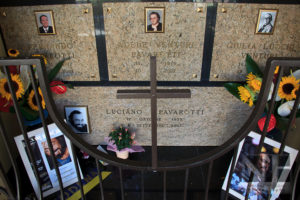
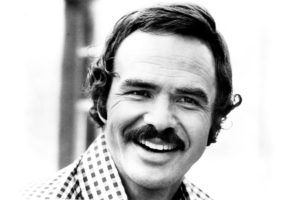 On this day in 2018, actor, director, producer, sex symbol and icon of American popular culture, Burt Reynolds died of a heart attack at the Jupiter Medical Center in Jupiter, Florida at the age of 82.. Born Burton Leon Reynolds Jr. on February 11, 1936 in Lansing, Michigan.
On this day in 2018, actor, director, producer, sex symbol and icon of American popular culture, Burt Reynolds died of a heart attack at the Jupiter Medical Center in Jupiter, Florida at the age of 82.. Born Burton Leon Reynolds Jr. on February 11, 1936 in Lansing, Michigan.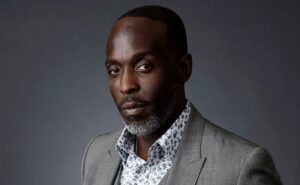 On this day in 2021 actor (The Wire, Boardwalk Empire) Michael K. Williams died in his apartment in Williamsburg, Brooklyn from an overdose of heroin laced with fentanyl, aged 54. Born Michael Kenneth Williams on November 22, 1966 in Brooklyn. He rose to fame in 2002 through his critically acclaimed role as Omar Little on the HBO drama series The Wire. He has been described as a “singular presence, onscreen and off, who made every role his own.”
On this day in 2021 actor (The Wire, Boardwalk Empire) Michael K. Williams died in his apartment in Williamsburg, Brooklyn from an overdose of heroin laced with fentanyl, aged 54. Born Michael Kenneth Williams on November 22, 1966 in Brooklyn. He rose to fame in 2002 through his critically acclaimed role as Omar Little on the HBO drama series The Wire. He has been described as a “singular presence, onscreen and off, who made every role his own.”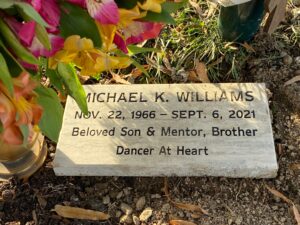 The Final Footprint
The Final Footprint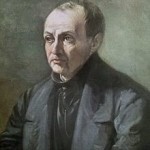 On this day in 1857, French philosopher, founder of the discipline of sociology and of the doctrine of positivism, Auguste Comte died in Paris at the age of 59 from stomach cancer. Born Isidore Auguste Marie François Xavier Comte in Montpellier, Hérault, in southern France on 19 January 1798. He was a founder of the discipline of sociology and of the doctrine of positivism. He is sometimes regarded as the first philosopher of science in the modern sense of the term. Strongly influenced by the utopian socialist Henri Saint-Simon, Comte developed the positive philosophy in an attempt to remedy the social malaise of the French Revolution, calling for a new social doctrine based on the sciences. Comte was a major influence on 19th-century thought. Comte’s social theories culminated in the “Religion of Humanity”, which influenced the development of religious humanist and secular humanist organizations in the 19th century. Comte coined the word altruisme (altruism).
On this day in 1857, French philosopher, founder of the discipline of sociology and of the doctrine of positivism, Auguste Comte died in Paris at the age of 59 from stomach cancer. Born Isidore Auguste Marie François Xavier Comte in Montpellier, Hérault, in southern France on 19 January 1798. He was a founder of the discipline of sociology and of the doctrine of positivism. He is sometimes regarded as the first philosopher of science in the modern sense of the term. Strongly influenced by the utopian socialist Henri Saint-Simon, Comte developed the positive philosophy in an attempt to remedy the social malaise of the French Revolution, calling for a new social doctrine based on the sciences. Comte was a major influence on 19th-century thought. Comte’s social theories culminated in the “Religion of Humanity”, which influenced the development of religious humanist and secular humanist organizations in the 19th century. Comte coined the word altruisme (altruism).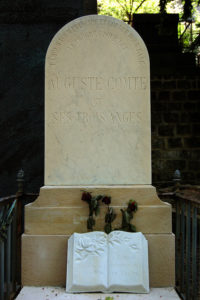 The Final Footprint – Comte is interred in Père Lachaise Cemetery, surrounded by cenotaphs in memory of his mother, Rosalie Boyer, and of Clotilde de Vaux, his muse. Other notable Final Footprints at Père Lachaise include; Guillaume Apollinaire, Georges Bizet, Honoré de Balzac, Jean-Dominique Bauby, Maria Callas, Frédéric Chopin, Colette, Jean-Baptiste-Camille Corot, Eugène Delacroix, Max Ernst, Molière, Jim Morrison, Édith Piaf, Camille Pissarro, Marcel Proust, Sully Prudhomme, Gioachino Rossini, Georges-Pierre Seurat, Gertrude Stein, Dorothea Tanning, Alice B. Toklas, Oscar Wilde, and Richard Wright.
The Final Footprint – Comte is interred in Père Lachaise Cemetery, surrounded by cenotaphs in memory of his mother, Rosalie Boyer, and of Clotilde de Vaux, his muse. Other notable Final Footprints at Père Lachaise include; Guillaume Apollinaire, Georges Bizet, Honoré de Balzac, Jean-Dominique Bauby, Maria Callas, Frédéric Chopin, Colette, Jean-Baptiste-Camille Corot, Eugène Delacroix, Max Ernst, Molière, Jim Morrison, Édith Piaf, Camille Pissarro, Marcel Proust, Sully Prudhomme, Gioachino Rossini, Georges-Pierre Seurat, Gertrude Stein, Dorothea Tanning, Alice B. Toklas, Oscar Wilde, and Richard Wright.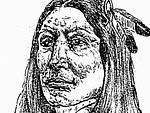 On this day in 1877, Native American war leader of the Oglala Lakota, Tasunke Witko (literally “His-Horse-Is-Crazy” or “His-Horse-Is-Spirited”), Crazy Horse, was fatally wounded, after surrendering to U.S. troops under General George Crook, while allegedly resisting imprisonment at Camp Robinson in present-day Nebraska (in the Pine Ridge region of northwest Nebraska). Born Cha-O-Ha (“In the Wilderness” or “Among the Trees”, meaning he was one with nature) sometime between 1840 and 1845 possibly somewhere on the South Cheyenne River. He took up arms against the U.S. Federal government to fight against encroachments on the territories and way of life of the Lakota people, including leading a war party to victory over George Armstrong Custer and his men at the Battle of the Little Bighorn in June 1876. Crazy Horse ranks among the most notable and iconic of Native American tribal members and has been honored by the U.S. Postal Service with a 13¢ Great Americans series postage stamp.
On this day in 1877, Native American war leader of the Oglala Lakota, Tasunke Witko (literally “His-Horse-Is-Crazy” or “His-Horse-Is-Spirited”), Crazy Horse, was fatally wounded, after surrendering to U.S. troops under General George Crook, while allegedly resisting imprisonment at Camp Robinson in present-day Nebraska (in the Pine Ridge region of northwest Nebraska). Born Cha-O-Ha (“In the Wilderness” or “Among the Trees”, meaning he was one with nature) sometime between 1840 and 1845 possibly somewhere on the South Cheyenne River. He took up arms against the U.S. Federal government to fight against encroachments on the territories and way of life of the Lakota people, including leading a war party to victory over George Armstrong Custer and his men at the Battle of the Little Bighorn in June 1876. Crazy Horse ranks among the most notable and iconic of Native American tribal members and has been honored by the U.S. Postal Service with a 13¢ Great Americans series postage stamp.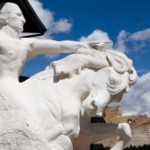
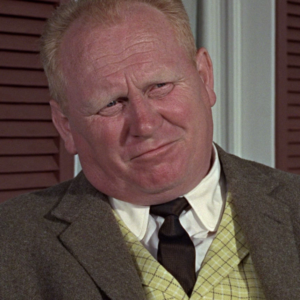
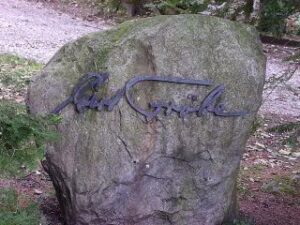

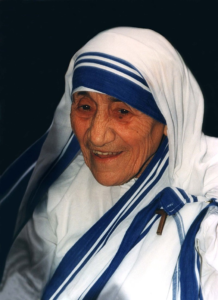 On this day in 1997, Mother Teresa, known in the Roman Catholic Church as Saint Teresa of Calcutta died in Calcutta at the age of 87. Born Anjezë Gonxhe Bojaxhiu on 26 August 1910 in Üsküp, Kosovo Vilayet, Ottoman Empire. After living in Macedonia for eighteen years she moved to Ireland and then to India, where she lived for most of her life.
On this day in 1997, Mother Teresa, known in the Roman Catholic Church as Saint Teresa of Calcutta died in Calcutta at the age of 87. Born Anjezë Gonxhe Bojaxhiu on 26 August 1910 in Üsküp, Kosovo Vilayet, Ottoman Empire. After living in Macedonia for eighteen years she moved to Ireland and then to India, where she lived for most of her life. The Final Footprint
The Final Footprint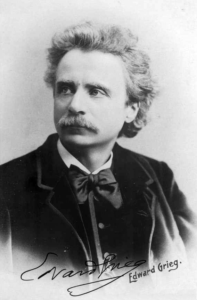 On this day in 1907, composer and pianist Edvard Grieg died at the Municipal Hospital in Bergen, Norway at age 64 from heart failure. Born Edvard Hagerup Grieg on 15 June 1843 in Bergen. In my opinion, he is one of the leading Romantic era composers, and his music is part of the standard classical repertoire worldwide. His use and development of Norwegian folk music in his own compositions brought the music of Norway to international consciousness, as well as helping to develop a national identity.
On this day in 1907, composer and pianist Edvard Grieg died at the Municipal Hospital in Bergen, Norway at age 64 from heart failure. Born Edvard Hagerup Grieg on 15 June 1843 in Bergen. In my opinion, he is one of the leading Romantic era composers, and his music is part of the standard classical repertoire worldwide. His use and development of Norwegian folk music in his own compositions brought the music of Norway to international consciousness, as well as helping to develop a national identity. The Final Footprint
The Final Footprint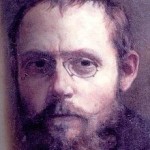 On this day in 1914, French poet, essayist, and editor Charles Péguy died in battle, shot in the forehead, in Villeroy, Seine-et-Marne during World War I, on the day before the beginning of the Battle of the Marne. Born on 7 January 1873 in Orléans. His two main philosophies were socialism and nationalism, but by 1908 at the latest, after years of uneasy agnosticism, he had become a believing but non-practicing Roman Catholic. From that time, Catholicism strongly influenced his works. In 1897, Péguy married Charlotte-Françoise Baudoin; they had one daughter and three sons, one of whom was born after Péguy’s death. Around 1910 he fell deeply in love with Blanche Raphael, a young Jewish friend; however, he was faithful to his wife.
On this day in 1914, French poet, essayist, and editor Charles Péguy died in battle, shot in the forehead, in Villeroy, Seine-et-Marne during World War I, on the day before the beginning of the Battle of the Marne. Born on 7 January 1873 in Orléans. His two main philosophies were socialism and nationalism, but by 1908 at the latest, after years of uneasy agnosticism, he had become a believing but non-practicing Roman Catholic. From that time, Catholicism strongly influenced his works. In 1897, Péguy married Charlotte-Françoise Baudoin; they had one daughter and three sons, one of whom was born after Péguy’s death. Around 1910 he fell deeply in love with Blanche Raphael, a young Jewish friend; however, he was faithful to his wife.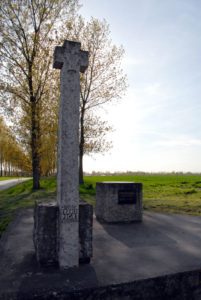 The Final Footprint – He is interred in a communal grave in the Grande Tombe de Villeroy, Seine-et-Marne, Ile-de-France, France. Péguy wrote: “There will be things that I do that no one will be left to understand.”
The Final Footprint – He is interred in a communal grave in the Grande Tombe de Villeroy, Seine-et-Marne, Ile-de-France, France. Péguy wrote: “There will be things that I do that no one will be left to understand.” On this day in 1991, singer and songwriter Dottie West died at the age of 58 from injuries sustained in a car accident at the Opryland exit on Briley Parkway in Nashville. Born Dorothy Marie Marsh outside McMinnville, Tennessee on 11 October 1932. In my opinion, West is one of country music’s most influential and groundbreaking female artists. Her career started in the early 1960s, with her Top 10 hit, “Here Comes My Baby Back Again,” which won her the first Grammy Award for Best Female Country Vocal Performance in 1965. In the 1960s, West was one of the few female country singers working in what was then a male-dominated industry. Throughout the 1960s, West had country hits within the Top 10 and 20. In the early 1970s, West wrote a popular commercial for the Coca-Cola company, titled “Country Sunshine”. She teamed up with country-pop superstar, Kenny Rogers for a series of duets earning Platinum selling albums and No. 1 records. Her duet recordings with Rogers, like “Every Time Two Fools Collide,” “All I Ever Need Is You,” and “What Are We Doin’ In Love,” eventually became country-pop standards. Her image and music came to the peak of her popularity as a solo act, and reaching No. 1 for the very first time on her own, in 1980 with her version of the Randy Goodrum and Brent Haher song, “A Lesson in Leavin’.
On this day in 1991, singer and songwriter Dottie West died at the age of 58 from injuries sustained in a car accident at the Opryland exit on Briley Parkway in Nashville. Born Dorothy Marie Marsh outside McMinnville, Tennessee on 11 October 1932. In my opinion, West is one of country music’s most influential and groundbreaking female artists. Her career started in the early 1960s, with her Top 10 hit, “Here Comes My Baby Back Again,” which won her the first Grammy Award for Best Female Country Vocal Performance in 1965. In the 1960s, West was one of the few female country singers working in what was then a male-dominated industry. Throughout the 1960s, West had country hits within the Top 10 and 20. In the early 1970s, West wrote a popular commercial for the Coca-Cola company, titled “Country Sunshine”. She teamed up with country-pop superstar, Kenny Rogers for a series of duets earning Platinum selling albums and No. 1 records. Her duet recordings with Rogers, like “Every Time Two Fools Collide,” “All I Ever Need Is You,” and “What Are We Doin’ In Love,” eventually became country-pop standards. Her image and music came to the peak of her popularity as a solo act, and reaching No. 1 for the very first time on her own, in 1980 with her version of the Randy Goodrum and Brent Haher song, “A Lesson in Leavin’.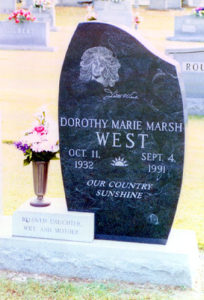 The Final Footprint – Her funeral was held at Christ Church on Old Hickory Boulevard. There were 600 friends and family attendees, including Emmylou Harris, Connie Smith, Johnny Cash and June Carter Cash and Larry Gatlin. Her friend and fellow artist, Steve Wariner, whom she had helped make it to Nashville as a young man, sang “Amazing Grace”. West is interred in Mount View Cemetery in McMinnville. Her grave is marked by an individual upright granite marker with the term of endearment; Beloved Daughter, Wife and Monther and Our Country Sunshine. On the back is the following; I was born a country girl I will die a country girl. My world is made of blue skies and sunshine, green fields and butterflies. I’m so glad I’m a country girl. McMinnville dedicated Highway 56 to her memory, naming it the Dottie West Memorial Highway. In 1995, actress Michele Lee, with the help of West’s daughter Shelly, produced and starred in the made-for-TV biopic Big Dreams and Broken Hearts: The Dottie West Story.
The Final Footprint – Her funeral was held at Christ Church on Old Hickory Boulevard. There were 600 friends and family attendees, including Emmylou Harris, Connie Smith, Johnny Cash and June Carter Cash and Larry Gatlin. Her friend and fellow artist, Steve Wariner, whom she had helped make it to Nashville as a young man, sang “Amazing Grace”. West is interred in Mount View Cemetery in McMinnville. Her grave is marked by an individual upright granite marker with the term of endearment; Beloved Daughter, Wife and Monther and Our Country Sunshine. On the back is the following; I was born a country girl I will die a country girl. My world is made of blue skies and sunshine, green fields and butterflies. I’m so glad I’m a country girl. McMinnville dedicated Highway 56 to her memory, naming it the Dottie West Memorial Highway. In 1995, actress Michele Lee, with the help of West’s daughter Shelly, produced and starred in the made-for-TV biopic Big Dreams and Broken Hearts: The Dottie West Story.  On this day in 2014,
On this day in 2014, 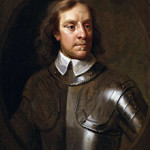 On this day in 1658, the man who abolished the monarchy and the 1st Lord Protector of the Commonwealth of England, Scotland, and Ireland, Oliver Cromwell, died at age 59 in Whitehall. A highly controversial figure in British history. Cromwell led the New Model Army which defeated the Royalists in the English civil war. Some historians regard him as a regicidal dictator, some as a hero of liberty. He was opposed to the Roman Catholic Church and he is widely hated in Ireland. Cromwell was one of the signers of King Charles I’s death warrant. Charles was executed on 30 January 1649. Cromwell suffered from malaria and is thought to have died from a urinary infection.
On this day in 1658, the man who abolished the monarchy and the 1st Lord Protector of the Commonwealth of England, Scotland, and Ireland, Oliver Cromwell, died at age 59 in Whitehall. A highly controversial figure in British history. Cromwell led the New Model Army which defeated the Royalists in the English civil war. Some historians regard him as a regicidal dictator, some as a hero of liberty. He was opposed to the Roman Catholic Church and he is widely hated in Ireland. Cromwell was one of the signers of King Charles I’s death warrant. Charles was executed on 30 January 1649. Cromwell suffered from malaria and is thought to have died from a urinary infection. The Final Footprint – Cromwell was initially entombed in Westminster Abbey. However, the Commonwealth soon fell apart without his leadership and Charles II, the son of Charles I, came back and the monarchy was reestablished. The Royalists had his body exhumed and on 30 January 1661, the 12th anniversary of the execution of Charles I, Cromwell’s body was posthumously executed. His body was hanged in chains at Tyburn. When the body was taken down, the head was severed and displayed on a pole outside Westminster Hall until 1685. Cromwell’s head exchanged hands several times until finally in 1960, it was buried at Sussex College in Cambridge. Several monuments have been erected in Cromwell’s honor;
The Final Footprint – Cromwell was initially entombed in Westminster Abbey. However, the Commonwealth soon fell apart without his leadership and Charles II, the son of Charles I, came back and the monarchy was reestablished. The Royalists had his body exhumed and on 30 January 1661, the 12th anniversary of the execution of Charles I, Cromwell’s body was posthumously executed. His body was hanged in chains at Tyburn. When the body was taken down, the head was severed and displayed on a pole outside Westminster Hall until 1685. Cromwell’s head exchanged hands several times until finally in 1960, it was buried at Sussex College in Cambridge. Several monuments have been erected in Cromwell’s honor;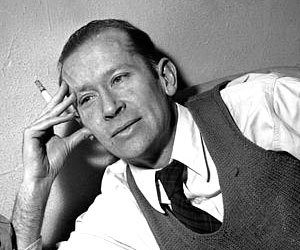 On this day in 1962, poet, painter, essayist, author, and playwright E. E. Cummings died of a stroke in North Conway, New Hampshire at the Memorial Hospital, at the age of 67. Born Edward Estlin Cummings on 14 October 1894 in Cambridge, Massachusetts. His body of work encompasses approximately 2,900 poems, two autobiographical novels, four plays and several essays, as well as numerous drawings and paintings. He is remembered as an eminent voice of 20th century poetry. Cummings married twice; Elaine Orr (1924 – 1924 divorce), Anne Minnerly Barton (1929 – 1934 divorce) and had a long term partner, Marion Morehouse (1932 – 1962 his death).
On this day in 1962, poet, painter, essayist, author, and playwright E. E. Cummings died of a stroke in North Conway, New Hampshire at the Memorial Hospital, at the age of 67. Born Edward Estlin Cummings on 14 October 1894 in Cambridge, Massachusetts. His body of work encompasses approximately 2,900 poems, two autobiographical novels, four plays and several essays, as well as numerous drawings and paintings. He is remembered as an eminent voice of 20th century poetry. Cummings married twice; Elaine Orr (1924 – 1924 divorce), Anne Minnerly Barton (1929 – 1934 divorce) and had a long term partner, Marion Morehouse (1932 – 1962 his death).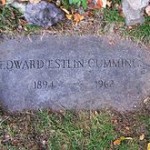 The Final Footprint – Cummings was cremated and his cremated remains were buried in Forest Hills Cemetery and Crematory in Boston. His grave is marked by a flat engraved stone. Cummings’ papers are held at the Houghton Library at Harvard University and the Harry Ransom Center at the University of Texas at Austin.
The Final Footprint – Cummings was cremated and his cremated remains were buried in Forest Hills Cemetery and Crematory in Boston. His grave is marked by a flat engraved stone. Cummings’ papers are held at the Houghton Library at Harvard University and the Harry Ransom Center at the University of Texas at Austin.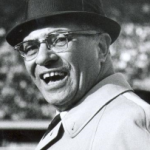 On this day in 1970 legendary football coach, 6x NFL Champion, 2x Super Bowl Champion, Green Bay Packers Hall of Fame, Pro Football Hall of Fame, Vince Lombardi died from cancer at Georgetown University Hospital in Washington D.C. at the age of 57. Born Vincent Thomas Lombardi on 11 June 1913 in Brooklyn; the grandson of Italian immigrants. The National Football League’s Super Bowl trophy is named in his honor. He never had a losing season as a head coach in the NFL, compiling a regular season winning percentage of 73.8% (96-34-6), a preseason winning percentage of 78.6% (44-12), and 90% (9-1) in the postseason for an overall record of 149 wins, 47 losses, and 6 ties in the NFL. Lombardi married Marie Planitz (1940 – 1970 his death).
On this day in 1970 legendary football coach, 6x NFL Champion, 2x Super Bowl Champion, Green Bay Packers Hall of Fame, Pro Football Hall of Fame, Vince Lombardi died from cancer at Georgetown University Hospital in Washington D.C. at the age of 57. Born Vincent Thomas Lombardi on 11 June 1913 in Brooklyn; the grandson of Italian immigrants. The National Football League’s Super Bowl trophy is named in his honor. He never had a losing season as a head coach in the NFL, compiling a regular season winning percentage of 73.8% (96-34-6), a preseason winning percentage of 78.6% (44-12), and 90% (9-1) in the postseason for an overall record of 149 wins, 47 losses, and 6 ties in the NFL. Lombardi married Marie Planitz (1940 – 1970 his death).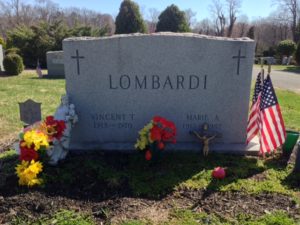 The Final Footprint – On September 7, the funeral was held at St. Patrick’s Cathedral in Manhattan. People lined Fifth Avenue and between 39th and 50th Street and Fifth Avenue was closed to traffic. Cardinal Terence Cooke delivered the eulogy. In attendance were team owners, NFL Commissioner Pete Rozelle, past and present members of the Packers, Redskins, and Giants, former students, colleagues, players, and classmates. Lombardi is buried next to his wife Marie and his parents Harry and Matilda, in Mount Olivet Cemetery in Middletown Township, New Jersey. His grave is marked by an upright companion granite marker.
The Final Footprint – On September 7, the funeral was held at St. Patrick’s Cathedral in Manhattan. People lined Fifth Avenue and between 39th and 50th Street and Fifth Avenue was closed to traffic. Cardinal Terence Cooke delivered the eulogy. In attendance were team owners, NFL Commissioner Pete Rozelle, past and present members of the Packers, Redskins, and Giants, former students, colleagues, players, and classmates. Lombardi is buried next to his wife Marie and his parents Harry and Matilda, in Mount Olivet Cemetery in Middletown Township, New Jersey. His grave is marked by an upright companion granite marker.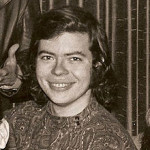 On this day in 1970, musician, singer, songwriter, “Blind Owl”, Alan Wilson died of an overdose of barbiturates in Topanga Canyon, California at age 27, thus becoming a member of the 27 Club or Forever 27 Club, a group of musicians who all died at the age of 27. Wilson was a member of the blues band Canned Heat. Two of their songs, “Going Up the Country” and “On the Road Again” became international hits.
On this day in 1970, musician, singer, songwriter, “Blind Owl”, Alan Wilson died of an overdose of barbiturates in Topanga Canyon, California at age 27, thus becoming a member of the 27 Club or Forever 27 Club, a group of musicians who all died at the age of 27. Wilson was a member of the blues band Canned Heat. Two of their songs, “Going Up the Country” and “On the Road Again” became international hits.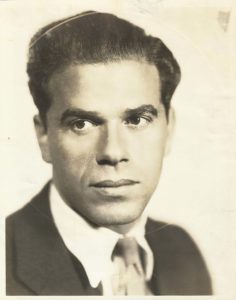 And on this day in 1991, Sicilian-born legendary American film director, Frank Capra died in La Quinta, California, of a heart attack in his sleep at the age of 94. Born Francesco Capra on 18 May 1897 in Bisacquino, Sicily, a village near Palermo.
And on this day in 1991, Sicilian-born legendary American film director, Frank Capra died in La Quinta, California, of a heart attack in his sleep at the age of 94. Born Francesco Capra on 18 May 1897 in Bisacquino, Sicily, a village near Palermo.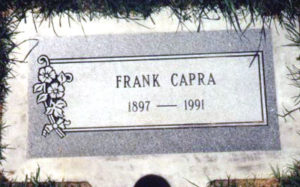 The Final Footprint – He is interred in the Coachella Valley Public Cemetery in Coachella, California. His grave is marked by a flat granite marker.
The Final Footprint – He is interred in the Coachella Valley Public Cemetery in Coachella, California. His grave is marked by a flat granite marker.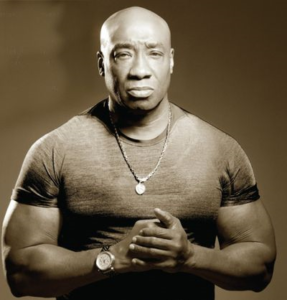 On this day in 2012, actor Michael Clarke Duncan died at
On this day in 2012, actor Michael Clarke Duncan died at 
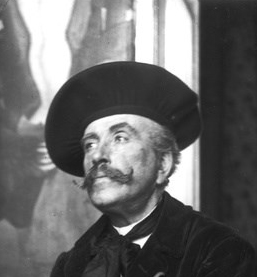 On this day in 1910, post-impressionist painter Henri Rousseau died in Paris at the age of 66. Born Henri Julien Félix Rousseau on May 21, 1844 in Laval, Mavenne. He was also known as Le Douanier (the customs officer), a humorous description of his occupation as a toll and tax collector. He started painting seriously in his early forties; by age 49, he retired from his job to work on his art full-time.
On this day in 1910, post-impressionist painter Henri Rousseau died in Paris at the age of 66. Born Henri Julien Félix Rousseau on May 21, 1844 in Laval, Mavenne. He was also known as Le Douanier (the customs officer), a humorous description of his occupation as a toll and tax collector. He started painting seriously in his early forties; by age 49, he retired from his job to work on his art full-time.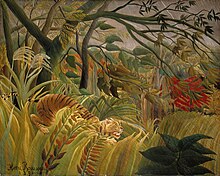

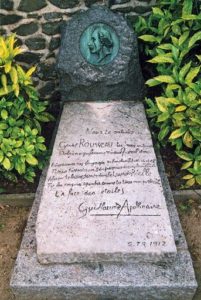





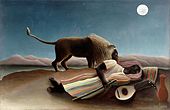







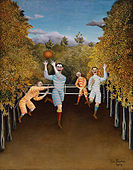





 On this day in 1973 writer, poet, philologist, and university professor, J.R.R. Tolkien died in Bournemouth, England at the age of 81. Born John Ronald Reuel Tolkien on 3 January 1892 in Bloemfontein in the Orange Free State (now Free State Province, part of South Africa). Best known as the author of the classic high fantasy works The Hobbit, The Lord of the Rings, and The Silmarillion. He was at one time a close friend of C. S. Lewis, both members of the informal literary discussion group known as the Inklings. Tolkien was appointed a Commander of the Order of the British Empire by Queen Elizabeth II on 28 March 1972. After his father’s death, Tolkien’s son Christopher published a series of works based on his father’s extensive notes and unpublished manuscripts, including The Silmarillion. These, together with The Hobbit and The Lord of the Rings form a connected body of tales, poems, fictional histories, invented languages, and literary essays about a fantasy world called Arda, and Middle-earth within it. Between 1951 and 1955, Tolkien applied the term legendarium to the larger part of these writings. While many other authors had published works of fantasy before Tolkien, the great success of The Hobbit and The Lord of the Rings led directly to a popular resurgence of the genre. This has caused Tolkien to be popularly identified as the “father” of modern fantasy literature or, more precisely, of high fantasy. Tolkien was married to Edith Mary Bratt (1916 – 1971 her death).
On this day in 1973 writer, poet, philologist, and university professor, J.R.R. Tolkien died in Bournemouth, England at the age of 81. Born John Ronald Reuel Tolkien on 3 January 1892 in Bloemfontein in the Orange Free State (now Free State Province, part of South Africa). Best known as the author of the classic high fantasy works The Hobbit, The Lord of the Rings, and The Silmarillion. He was at one time a close friend of C. S. Lewis, both members of the informal literary discussion group known as the Inklings. Tolkien was appointed a Commander of the Order of the British Empire by Queen Elizabeth II on 28 March 1972. After his father’s death, Tolkien’s son Christopher published a series of works based on his father’s extensive notes and unpublished manuscripts, including The Silmarillion. These, together with The Hobbit and The Lord of the Rings form a connected body of tales, poems, fictional histories, invented languages, and literary essays about a fantasy world called Arda, and Middle-earth within it. Between 1951 and 1955, Tolkien applied the term legendarium to the larger part of these writings. While many other authors had published works of fantasy before Tolkien, the great success of The Hobbit and The Lord of the Rings led directly to a popular resurgence of the genre. This has caused Tolkien to be popularly identified as the “father” of modern fantasy literature or, more precisely, of high fantasy. Tolkien was married to Edith Mary Bratt (1916 – 1971 her death).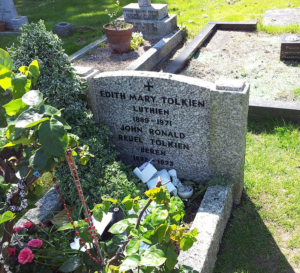 The Final Footprint – Tolkien is interred with his wife Edith in Wolvercote Cemetery, Oxford, England. Their graves are marked by an upright companion granite marker.
The Final Footprint – Tolkien is interred with his wife Edith in Wolvercote Cemetery, Oxford, England. Their graves are marked by an upright companion granite marker.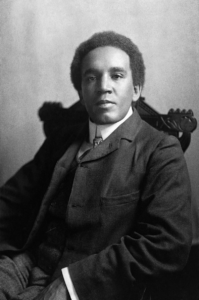 On this day in 1912 composer Samuel Coleridge-Taylor died from pneumonia in Holborn, London at the age of 37. Born on 15 August 1875 in Croydon, Surrey, England. Coleridge-Taylor achieved such success that he was referred to by white New York musicians as the “African Mahler” at the time when he had three tours of the United States in the early 1900s. He was particularly known for his three cantatas based on the epic poem, Song of Hiawatha by American Henry Wadsworth Longfellow. Coleridge-Taylor premiered the first section in 1898, when he was 22.
On this day in 1912 composer Samuel Coleridge-Taylor died from pneumonia in Holborn, London at the age of 37. Born on 15 August 1875 in Croydon, Surrey, England. Coleridge-Taylor achieved such success that he was referred to by white New York musicians as the “African Mahler” at the time when he had three tours of the United States in the early 1900s. He was particularly known for his three cantatas based on the epic poem, Song of Hiawatha by American Henry Wadsworth Longfellow. Coleridge-Taylor premiered the first section in 1898, when he was 22.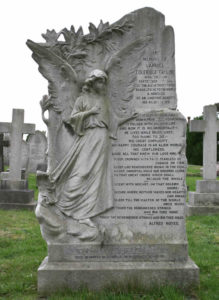 The Final Footprint
The Final Footprint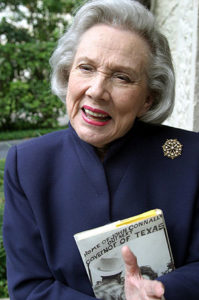 On this day in 2006, aspiring actress, graduate of the University of Texas, former First Lady of Texas, author and last survivor of the Lincoln limousine that carried President John F. Kennedy, Nellie Connally died peacefully at her home in Austin, Texas at the age of 87. Born Idanell Brill in Austin on 24 February 1919. She auditioned for the roll of Scarlett O’Hara.
On this day in 2006, aspiring actress, graduate of the University of Texas, former First Lady of Texas, author and last survivor of the Lincoln limousine that carried President John F. Kennedy, Nellie Connally died peacefully at her home in Austin, Texas at the age of 87. Born Idanell Brill in Austin on 24 February 1919. She auditioned for the roll of Scarlett O’Hara.
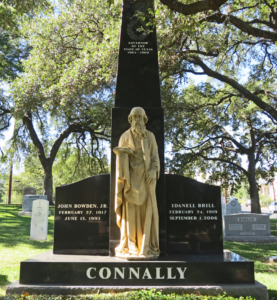 The Final Footprint – The Connally’s are buried together at the Texas State Cemetery in Austin. Texans widely regard her as a beloved daughter of the great state of Texas. Other notable final footprints at Texas State Cemetery include; Stephen F. Austin, J. Frank Dobie, Barbara Jordan, Tom Landry (cenotaph), James A. Michener (cenotaph), Ann Richards, Edwin “Bud” Shrake, Big Foot Wallace, and Walter Prescott Webb. What are your thoughts on the conspiracy theories surrounding JFK’s assassination?
The Final Footprint – The Connally’s are buried together at the Texas State Cemetery in Austin. Texans widely regard her as a beloved daughter of the great state of Texas. Other notable final footprints at Texas State Cemetery include; Stephen F. Austin, J. Frank Dobie, Barbara Jordan, Tom Landry (cenotaph), James A. Michener (cenotaph), Ann Richards, Edwin “Bud” Shrake, Big Foot Wallace, and Walter Prescott Webb. What are your thoughts on the conspiracy theories surrounding JFK’s assassination?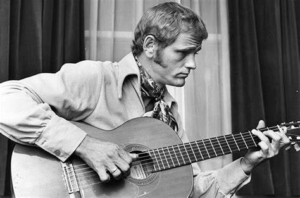 On this day in 2008 singer, guitarist, songwriter and actor Jerry Reed died in Nashville, Tennessee of complications from emphysema, at the age of 71. Born Jerry Reed Hubbard on 20 March 1937 in Atlanta, Georgia. His signature songs include “Guitar Man,” “U.S. Male”, “A Thing Called Love,” “Alabama Wild Man,” “Amos Moses”, “When You’re Hot, You’re Hot” (which garnered a Grammy Award for Best Male Country Vocal Performance), “Ko-Ko Joe”, “Lord, Mr. Ford”, “East Bound and Down” (the theme song for the 1977 blockbuster Smokey and the Bandit, in which Reed co-starred along with Jackie Gleason, Burt Reynolds and Sally Field), “The Bird,” and “She Got the Goldmine (I Got the Shaft)”. Reed was married to Priscilla Mitchell (1959 – 2008 his death).
On this day in 2008 singer, guitarist, songwriter and actor Jerry Reed died in Nashville, Tennessee of complications from emphysema, at the age of 71. Born Jerry Reed Hubbard on 20 March 1937 in Atlanta, Georgia. His signature songs include “Guitar Man,” “U.S. Male”, “A Thing Called Love,” “Alabama Wild Man,” “Amos Moses”, “When You’re Hot, You’re Hot” (which garnered a Grammy Award for Best Male Country Vocal Performance), “Ko-Ko Joe”, “Lord, Mr. Ford”, “East Bound and Down” (the theme song for the 1977 blockbuster Smokey and the Bandit, in which Reed co-starred along with Jackie Gleason, Burt Reynolds and Sally Field), “The Bird,” and “She Got the Goldmine (I Got the Shaft)”. Reed was married to Priscilla Mitchell (1959 – 2008 his death).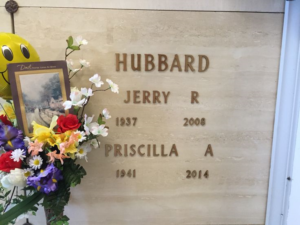 The Final Footprint – Reed is entombed in the Cross Mausoleum in Woodlawn Memorial Park in Nashville. Other notable Final Footprints at Woodlawn include; Eddy Arnold, Little Jimmy Dickens, George Jones, Johnny Paycheck, Webb Pierce, Marty Robbins, Dan Seals, Red Sovine, Porter Wagoner, and Tammy Wynette.
The Final Footprint – Reed is entombed in the Cross Mausoleum in Woodlawn Memorial Park in Nashville. Other notable Final Footprints at Woodlawn include; Eddy Arnold, Little Jimmy Dickens, George Jones, Johnny Paycheck, Webb Pierce, Marty Robbins, Dan Seals, Red Sovine, Porter Wagoner, and Tammy Wynette. On this day in 1867, French poet, essayist, art critic, translator, Charles Baudelaire died in Paris at the age of 46. Born Charles Pierre Baudelaire on 9 April 1821 in Paris. Produced notable work as an essayist, art critic, and pioneering translator of Edgar Allan Poe. His most famous work, Les Fleurs du mal (The Flowers of Evil), expresses the changing nature of beauty in modern, industrializing Paris during the 19th century. Baudelaire’s highly original style of prose-poetry influenced a whole generation of poets. He is credited with coining the term “modernity” (modernité) to designate the fleeting, ephemeral experience of life in an urban metropolis, and the responsibility art has to capture that experience. In my opinion, he is one of the major innovators of French literature. For 20 years, Jeanne Duval was the muse of Baudelaire. They met in 1842, when Duval left Haiti for France, and the two remained together, albeit stormily, for the next two decades. Duval is said to have been the woman whom Baudelaire loved most, in his life, after his mother. She was born in Haiti on an unknown date, sometime around 1820. Poems of Baudelaire’s which are dedicated to Duval or pay her homage are: Le balcon, Parfum exotique, La chevelure, Sed non satiata, Le serpent qui danse, and Une charogne. Baudelaire called her “mistress of mistresses” and his “Vénus Noire” (“Black Venus”), and it is believed that, to him, Duval symbolized the dangerous beauty, sexuality, and mystery of a Creole woman in mid-nineteenth century France. He is perhaps my favorite poet.
On this day in 1867, French poet, essayist, art critic, translator, Charles Baudelaire died in Paris at the age of 46. Born Charles Pierre Baudelaire on 9 April 1821 in Paris. Produced notable work as an essayist, art critic, and pioneering translator of Edgar Allan Poe. His most famous work, Les Fleurs du mal (The Flowers of Evil), expresses the changing nature of beauty in modern, industrializing Paris during the 19th century. Baudelaire’s highly original style of prose-poetry influenced a whole generation of poets. He is credited with coining the term “modernity” (modernité) to designate the fleeting, ephemeral experience of life in an urban metropolis, and the responsibility art has to capture that experience. In my opinion, he is one of the major innovators of French literature. For 20 years, Jeanne Duval was the muse of Baudelaire. They met in 1842, when Duval left Haiti for France, and the two remained together, albeit stormily, for the next two decades. Duval is said to have been the woman whom Baudelaire loved most, in his life, after his mother. She was born in Haiti on an unknown date, sometime around 1820. Poems of Baudelaire’s which are dedicated to Duval or pay her homage are: Le balcon, Parfum exotique, La chevelure, Sed non satiata, Le serpent qui danse, and Une charogne. Baudelaire called her “mistress of mistresses” and his “Vénus Noire” (“Black Venus”), and it is believed that, to him, Duval symbolized the dangerous beauty, sexuality, and mystery of a Creole woman in mid-nineteenth century France. He is perhaps my favorite poet.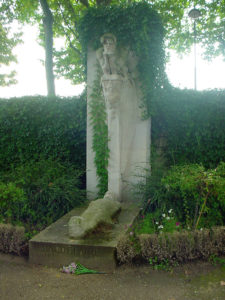 The Final Footprint – Baudelaire is buried in the Cimetière du Montparnasse, Paris. Other notable Final Footprints at Montparnasse include; Samuel Beckett, Simone de Beauvoir, Emmanuel Chabrier, Guy de Maupassant, Adah Isaacs Menken, Camille Saint-Saëns, Jean-Paul Sartre,
The Final Footprint – Baudelaire is buried in the Cimetière du Montparnasse, Paris. Other notable Final Footprints at Montparnasse include; Samuel Beckett, Simone de Beauvoir, Emmanuel Chabrier, Guy de Maupassant, Adah Isaacs Menken, Camille Saint-Saëns, Jean-Paul Sartre, 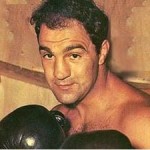 On this day in 1969 Italian-American boxing heavyweight champion of the world, The Brockton Blockbuster, The Rock of Brockton, Rocky Marciano died when the small private plane he was a passenger on crashed near Newton, Iowa, the day before his 46th birthday. Born Rocco Francis Marchegiano on 1 September 1923 in Brockton, Massachusetts. Marciano is the only person to hold the heavyweight title and go untied and undefeated throughout his career. Marciano defended his title six times, against Jersey Joe Walcott, Roland LaStarza, Ezzard Charles (2x), Don Cockell and Archie Moore.
On this day in 1969 Italian-American boxing heavyweight champion of the world, The Brockton Blockbuster, The Rock of Brockton, Rocky Marciano died when the small private plane he was a passenger on crashed near Newton, Iowa, the day before his 46th birthday. Born Rocco Francis Marchegiano on 1 September 1923 in Brockton, Massachusetts. Marciano is the only person to hold the heavyweight title and go untied and undefeated throughout his career. Marciano defended his title six times, against Jersey Joe Walcott, Roland LaStarza, Ezzard Charles (2x), Don Cockell and Archie Moore.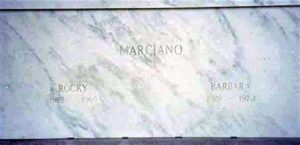 The Final Footprint – Marciano is entombed in the mausoleum at Forest Lawn Memorial Gardens Central in Fort Lauderdale, Florida.
The Final Footprint – Marciano is entombed in the mausoleum at Forest Lawn Memorial Gardens Central in Fort Lauderdale, Florida.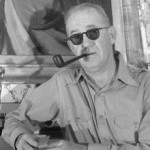 On this day in 1973, United States Navy veteran, film director, 4x Academy Award winner for Best Director (which is a record), John Ford died in Palm Desert, California at the age of 79. Born John Martin Feeney on 1 February 1894 in Cape Elizabeth, Maine. Ford was famous for his Westerns such as Stagecoach (1939), The Searchers (1956), and The Man Who Shot Liberty Valance (1962). In a career that spanned more than 50 years, Ford directed more than 140 films and he is widely regarded as one of the most important and influential filmmakers of his generation. Ford’s films and personality were held in high regard by his colleagues. In particular, Ford was a pioneer of location shooting and the long shot which frames his characters against a vast, harsh and rugged natural terrain. Ford was instrumental in launching the career of his friend, John Wayne.
On this day in 1973, United States Navy veteran, film director, 4x Academy Award winner for Best Director (which is a record), John Ford died in Palm Desert, California at the age of 79. Born John Martin Feeney on 1 February 1894 in Cape Elizabeth, Maine. Ford was famous for his Westerns such as Stagecoach (1939), The Searchers (1956), and The Man Who Shot Liberty Valance (1962). In a career that spanned more than 50 years, Ford directed more than 140 films and he is widely regarded as one of the most important and influential filmmakers of his generation. Ford’s films and personality were held in high regard by his colleagues. In particular, Ford was a pioneer of location shooting and the long shot which frames his characters against a vast, harsh and rugged natural terrain. Ford was instrumental in launching the career of his friend, John Wayne.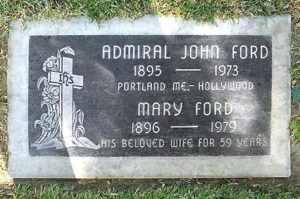 The Final Footprint – Ford’s funeral was held on 5 September at Hollywood’s Church of the Blessed Sacrament. He was interred in Holy Cross Cemetery in Culver City, California. Other notable final footprints at Holy Cross include; John Candy, Bing Crosby, Jimmy Durante, Chick Hearn, Rita Hayworth, Bela Lugosi, Al Martino, Audrey Meadows, Ricardo Montalbán, Chris Penn, Jo Stafford, and Sharon Tate.
The Final Footprint – Ford’s funeral was held on 5 September at Hollywood’s Church of the Blessed Sacrament. He was interred in Holy Cross Cemetery in Culver City, California. Other notable final footprints at Holy Cross include; John Candy, Bing Crosby, Jimmy Durante, Chick Hearn, Rita Hayworth, Bela Lugosi, Al Martino, Audrey Meadows, Ricardo Montalbán, Chris Penn, Jo Stafford, and Sharon Tate. On this day in 1997, the first wife of Charles, Prince of Wales, the eldest child and heir apparent of Queen Elizabeth II, the Princess of Wales, Diana died in a car crash in the Pont de l’Alma road tunnel in Paris along with her then boyfriend, Dodi Al-Fayed and their chauffeur Henri Paul, at the age of 36. Born Diana Frances Spencer on 1 July 1961 in Park House, Sandringham, Norfolk, England into the Spencer family, a British noble family descended in the male line from Henry Spencer (died c. 1478), male-line ancestor of the Earls of Sunderland, the later Dukes of Marlborough, and the Earls Spencer. Sir Winston Churchill was a grandson of the 7th Duke of Marlborough. Diana became Lady Diana Spencer when her father inherited the title of Earl Spencer in 1975. She became a public figure with the announcement of her engagement. Her wedding to Charles on 29 July 1981 was held at St Paul’s Cathedral and seen by a global television audience of over 750 million. While married she bore the titles Princess of Wales, Duchess of Cornwall, Duchess of Rothesay, Countess of Chester and Baroness of Renfrew. The marriage produced two sons, the princes William and Harry, who were respectively second and third in the line of succession to the British throne throughout her lifetime. After her marriage, she undertook a variety of public engagements. She was well known for her fund-raising work for international charities and as an eminent celebrity of the late 20th century. She also received recognition for her charity work and for her support of the International Campaign to Ban Landmines. From 1989, she was the president of Great Ormond Street Hospital for children, in addition to dozens of other charities. Diana remained the object of worldwide media scrutiny during and after her marriage, which ended in divorce on 28 August 1996.
On this day in 1997, the first wife of Charles, Prince of Wales, the eldest child and heir apparent of Queen Elizabeth II, the Princess of Wales, Diana died in a car crash in the Pont de l’Alma road tunnel in Paris along with her then boyfriend, Dodi Al-Fayed and their chauffeur Henri Paul, at the age of 36. Born Diana Frances Spencer on 1 July 1961 in Park House, Sandringham, Norfolk, England into the Spencer family, a British noble family descended in the male line from Henry Spencer (died c. 1478), male-line ancestor of the Earls of Sunderland, the later Dukes of Marlborough, and the Earls Spencer. Sir Winston Churchill was a grandson of the 7th Duke of Marlborough. Diana became Lady Diana Spencer when her father inherited the title of Earl Spencer in 1975. She became a public figure with the announcement of her engagement. Her wedding to Charles on 29 July 1981 was held at St Paul’s Cathedral and seen by a global television audience of over 750 million. While married she bore the titles Princess of Wales, Duchess of Cornwall, Duchess of Rothesay, Countess of Chester and Baroness of Renfrew. The marriage produced two sons, the princes William and Harry, who were respectively second and third in the line of succession to the British throne throughout her lifetime. After her marriage, she undertook a variety of public engagements. She was well known for her fund-raising work for international charities and as an eminent celebrity of the late 20th century. She also received recognition for her charity work and for her support of the International Campaign to Ban Landmines. From 1989, she was the president of Great Ormond Street Hospital for children, in addition to dozens of other charities. Diana remained the object of worldwide media scrutiny during and after her marriage, which ended in divorce on 28 August 1996.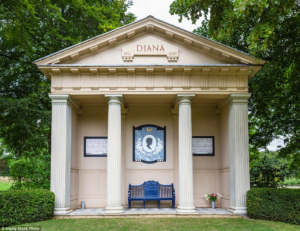 The Final Footprint – The sudden and unexpected death of an extraordinarily popular royal figure brought statements from senior figures worldwide and many tributes by members of the public. People left public offerings of flowers, candles, cards and personal messages outside Kensington Palace for many months. Her coffin, draped with royal flag, was brought to London from Paris by Prince Charles and her two sisters on 31 August 1997. After being taken to a private mortuary it was put at the Chapel Royal, St. James’s Palace. Diana’s funeral took place in Westminster Abbey on 6 September. The previous day Queen Elizabeth II had paid tribute to her in a live television broadcast. Her sons walked in the funeral procession behind her coffin, along with the Prince of Wales and the Duke of Edinburgh, and with Diana’s brother, Charles Spencer, 9th Earl Spencer. Lord Spencer said of his sister, “She proved in the last year that she needed no royal title to continue to generate her particular brand of magic.” Princess Diana is entombed in a private mausoleum on the Island on the lake Oval on the grounds of the Spencer Estate in Althorp. Permanent memorials include:
The Final Footprint – The sudden and unexpected death of an extraordinarily popular royal figure brought statements from senior figures worldwide and many tributes by members of the public. People left public offerings of flowers, candles, cards and personal messages outside Kensington Palace for many months. Her coffin, draped with royal flag, was brought to London from Paris by Prince Charles and her two sisters on 31 August 1997. After being taken to a private mortuary it was put at the Chapel Royal, St. James’s Palace. Diana’s funeral took place in Westminster Abbey on 6 September. The previous day Queen Elizabeth II had paid tribute to her in a live television broadcast. Her sons walked in the funeral procession behind her coffin, along with the Prince of Wales and the Duke of Edinburgh, and with Diana’s brother, Charles Spencer, 9th Earl Spencer. Lord Spencer said of his sister, “She proved in the last year that she needed no royal title to continue to generate her particular brand of magic.” Princess Diana is entombed in a private mausoleum on the Island on the lake Oval on the grounds of the Spencer Estate in Althorp. Permanent memorials include: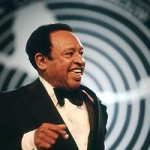 On this day in 2002 jazz vibraphonist, pianist, percussionist, bandleader and actor, Gates, Hamp, Mad Lionel, Lionel Hampton died from congestive heart failure at Mount Sinai Hospital in New York City, at the age of 94. Born Lionel Leo Hampton on 20 April 1908 in Louisville, Kentucky. Hampton was one of the first jazz vibraphone players and ranks among the great names in jazz history. Hampton married Gladys Riddle (1936-1971 her death).
On this day in 2002 jazz vibraphonist, pianist, percussionist, bandleader and actor, Gates, Hamp, Mad Lionel, Lionel Hampton died from congestive heart failure at Mount Sinai Hospital in New York City, at the age of 94. Born Lionel Leo Hampton on 20 April 1908 in Louisville, Kentucky. Hampton was one of the first jazz vibraphone players and ranks among the great names in jazz history. Hampton married Gladys Riddle (1936-1971 her death).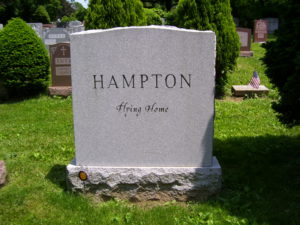 The Final Footprint – His funeral was held on 7 September 2002 and featured a performance by Wynton Marsalis and David Ostwald’s Gully Low Jazz Band at Riverside Church in Manhattan; the procession began at The Cotton Club in Harlem. Hampton is interred in Woodlawn Cemetery in the Bronx. His grave is marked by a large upright companion granite marker and a granite foot marker. His epitaph is, “Flying Home.” Other notable Final Footprints at Woodlawn include; Irving Berlin, Miles Davis, Duke Ellington, Fiorello La Guardia, Rowland Macy, Bat Masterson, Herman Melville, J. C. Penney, and Joseph Pulitzer.
The Final Footprint – His funeral was held on 7 September 2002 and featured a performance by Wynton Marsalis and David Ostwald’s Gully Low Jazz Band at Riverside Church in Manhattan; the procession began at The Cotton Club in Harlem. Hampton is interred in Woodlawn Cemetery in the Bronx. His grave is marked by a large upright companion granite marker and a granite foot marker. His epitaph is, “Flying Home.” Other notable Final Footprints at Woodlawn include; Irving Berlin, Miles Davis, Duke Ellington, Fiorello La Guardia, Rowland Macy, Bat Masterson, Herman Melville, J. C. Penney, and Joseph Pulitzer. On this day in 1979, actress Jean Seberg died at the age of 40 from an apparent intentional overdose of barbiturates in the back seat of her Renault, which was parked close to her Paris apartment in the 16th arrondissement. Born Jean Dorothy Seberg on 13 November 1938 in Marshalltown, Iowa. She starred in 37 films in Hollywood and in Europe, including Bonjour Tristesse (1958), À bout de soufflé (Breathless) (1960), the musical Paint Your Wagon (1969), and the disaster film Airport (1970). Seberg is also one of the best-known targets of the FBI COINTELPRO project. Her victimization was rendered as a well-documented retaliation for her support of civil rights and activist groups in the 1960s. Seberg married François Moreuil (1958 – 1960 divorce), Romain Gary (1963 – 1970 divorce) and Dennis Berry (1972 – 1979 separated, her death).
On this day in 1979, actress Jean Seberg died at the age of 40 from an apparent intentional overdose of barbiturates in the back seat of her Renault, which was parked close to her Paris apartment in the 16th arrondissement. Born Jean Dorothy Seberg on 13 November 1938 in Marshalltown, Iowa. She starred in 37 films in Hollywood and in Europe, including Bonjour Tristesse (1958), À bout de soufflé (Breathless) (1960), the musical Paint Your Wagon (1969), and the disaster film Airport (1970). Seberg is also one of the best-known targets of the FBI COINTELPRO project. Her victimization was rendered as a well-documented retaliation for her support of civil rights and activist groups in the 1960s. Seberg married François Moreuil (1958 – 1960 divorce), Romain Gary (1963 – 1970 divorce) and Dennis Berry (1972 – 1979 separated, her death). The Final Footprint – Seberg was interred in the Cimetière du Montparnasse, Paris. Montparnasse Cemetery is the eternal home of many of France’s intellectual and artistic elite as well as publishers and others who promoted the works of authors and artists. There are also monuments to police and firefighters killed in the line of duty in the city of Paris. There are also many graves of foreigners who have made France their home. The cemetery is divided by Rue Émile Richard. The small section is usually referred to as the small cemetery (petit cimetière) and the large section as the big cemetery (grand cimetière). Other notable Final Footprints at Montparnasse include; Charles Baudelaire, Simone de Beauvoir, Samuel Beckett, Emmanuel Chabrier, Alfred Dreyfus, Marguerite Duras, Henri Fantin-Latour, César Franck, André Lhote, Guy de Maupassant, Adah Isaacs Menken, Man Ray, Camille Saint-Saëns, Jean-Paul Sartre, and Susan Sontag.
The Final Footprint – Seberg was interred in the Cimetière du Montparnasse, Paris. Montparnasse Cemetery is the eternal home of many of France’s intellectual and artistic elite as well as publishers and others who promoted the works of authors and artists. There are also monuments to police and firefighters killed in the line of duty in the city of Paris. There are also many graves of foreigners who have made France their home. The cemetery is divided by Rue Émile Richard. The small section is usually referred to as the small cemetery (petit cimetière) and the large section as the big cemetery (grand cimetière). Other notable Final Footprints at Montparnasse include; Charles Baudelaire, Simone de Beauvoir, Samuel Beckett, Emmanuel Chabrier, Alfred Dreyfus, Marguerite Duras, Henri Fantin-Latour, César Franck, André Lhote, Guy de Maupassant, Adah Isaacs Menken, Man Ray, Camille Saint-Saëns, Jean-Paul Sartre, and Susan Sontag. On this day in 2003 actor Charles Bronson died of pneumonia at Cedars-Sinai Medical Center in Los Angeles at the age of 81. Born Charles Dennis Buchinski 3 November 1921 in Ehrenfeld, Pennsylvania. My favorite Bronson movies inlcude: John Sturges’ The Magnificent Seven (1960) with Yul Brynner, Steve McQueen, James Coburn, Robert Vaughn and Eli Wallach and filmscore by Elmer Bernstein; The Dirty Dozen (1967) with Lee Marvin, Ernest Borgnine, Telly Savalas, and Jim Brown; Sergio Leone’s Once Upon a Time in the West (1968) with Claudia Cardinale, Henry Fonda and Jason Robards; as Wild Bill Hickok in The White Buffalo (1977) with Kim Novak, Jack Warden, Slim Pickens and Will Sampson; as Albert Johnson in Death Hunt (1981) with Lee Marvin, Angie Dickinson and Carl Weathers. Bronson was married three times; Harriet Tendler (1949-1967 divorce), actress Jill Ireland (1968-1990 her death) and Kim Weeks (1998-2003 his death).
On this day in 2003 actor Charles Bronson died of pneumonia at Cedars-Sinai Medical Center in Los Angeles at the age of 81. Born Charles Dennis Buchinski 3 November 1921 in Ehrenfeld, Pennsylvania. My favorite Bronson movies inlcude: John Sturges’ The Magnificent Seven (1960) with Yul Brynner, Steve McQueen, James Coburn, Robert Vaughn and Eli Wallach and filmscore by Elmer Bernstein; The Dirty Dozen (1967) with Lee Marvin, Ernest Borgnine, Telly Savalas, and Jim Brown; Sergio Leone’s Once Upon a Time in the West (1968) with Claudia Cardinale, Henry Fonda and Jason Robards; as Wild Bill Hickok in The White Buffalo (1977) with Kim Novak, Jack Warden, Slim Pickens and Will Sampson; as Albert Johnson in Death Hunt (1981) with Lee Marvin, Angie Dickinson and Carl Weathers. Bronson was married three times; Harriet Tendler (1949-1967 divorce), actress Jill Ireland (1968-1990 her death) and Kim Weeks (1998-2003 his death). The Final Footprint – Bronson is buried in Brownsville Cemetery in West Windsor, Vermont. His grave is marked with a full ledger engraved granite marker. It is engraved with the term of endearment, Cherished Husband and Father and with the following popular bereavement poem by Mary Elizabeth Frye:
The Final Footprint – Bronson is buried in Brownsville Cemetery in West Windsor, Vermont. His grave is marked with a full ledger engraved granite marker. It is engraved with the term of endearment, Cherished Husband and Father and with the following popular bereavement poem by Mary Elizabeth Frye: n this day in 2006 actor (Gilda, The Big Heat, Blackboard Jungle, 3:10 to Yuma, Superman) Glenn Ford died in his Beverly Hills home at the age of 90. He often portrayed ordinary men in unusual circumstances. Ford was most prominent during Hollywood’s Golden Age as one of the biggest box-office draws of the 1940s, 1950s, and 1960s, who had a career that lasted more than 50 years. Although he played in many genres of movies, some of his most significant roles were in the film noirs Gilda (1946) and The Big Heat (1953), and the high school angst film Blackboard Jungle (1955). However, it was for comedies or westerns which he received acting laurels, including three Golden Globe Nominations for Best Actor in a Comedy movie, winning for Pocketful of Miracles (1961). He also played a supporting role as Clark Kent’s adoptive father, Jonathan Kent, in Superman (1978). Five of his films have been selected for the National Film Registry by the Library of Congress as being “culturally, historically or aesthetically” significant: Gilda (1946), The Big Heat (1953), Blackboard Jungle (1955), 3:10 to Yuma (1957) and Superman (1978).
n this day in 2006 actor (Gilda, The Big Heat, Blackboard Jungle, 3:10 to Yuma, Superman) Glenn Ford died in his Beverly Hills home at the age of 90. He often portrayed ordinary men in unusual circumstances. Ford was most prominent during Hollywood’s Golden Age as one of the biggest box-office draws of the 1940s, 1950s, and 1960s, who had a career that lasted more than 50 years. Although he played in many genres of movies, some of his most significant roles were in the film noirs Gilda (1946) and The Big Heat (1953), and the high school angst film Blackboard Jungle (1955). However, it was for comedies or westerns which he received acting laurels, including three Golden Globe Nominations for Best Actor in a Comedy movie, winning for Pocketful of Miracles (1961). He also played a supporting role as Clark Kent’s adoptive father, Jonathan Kent, in Superman (1978). Five of his films have been selected for the National Film Registry by the Library of Congress as being “culturally, historically or aesthetically” significant: Gilda (1946), The Big Heat (1953), Blackboard Jungle (1955), 3:10 to Yuma (1957) and Superman (1978). The Final Footprint– Entombed in Woodlawn Memorial Cemetery, Santa Monica, California. Other notable Final Footprints at Woodlawn include; Barbara Billingsley, Harvey Korman, Doug McClure, Bess Myerson, Sally Ride, and Irene Ryan.
The Final Footprint– Entombed in Woodlawn Memorial Cemetery, Santa Monica, California. Other notable Final Footprints at Woodlawn include; Barbara Billingsley, Harvey Korman, Doug McClure, Bess Myerson, Sally Ride, and Irene Ryan. On this day in 2013, poet, playwright Seamus Heaney died in the Blackrock Clinic in Dublin, aged 74. Born Seamus Justin Heaney on 13 April 1939 in the townland of Tamniaran between Castledawson and Toomebridge, Northern Ireland. He received the 1995 Nobel Prize in Literature. Perhaps best known for his work Death of a Naturalist (1966), his first major published volume. Robert Lowell described him as “the most important Irish poet since Yeats”.
On this day in 2013, poet, playwright Seamus Heaney died in the Blackrock Clinic in Dublin, aged 74. Born Seamus Justin Heaney on 13 April 1939 in the townland of Tamniaran between Castledawson and Toomebridge, Northern Ireland. He received the 1995 Nobel Prize in Literature. Perhaps best known for his work Death of a Naturalist (1966), his first major published volume. Robert Lowell described him as “the most important Irish poet since Yeats”. The Final Footprint
The Final Footprint On this day in 2015
On this day in 2015  The Final Footprint
The Final Footprint